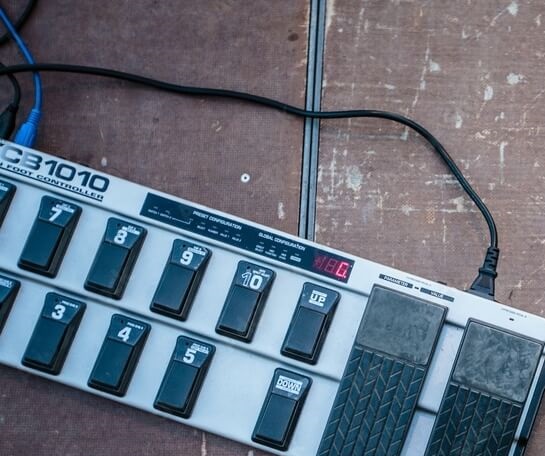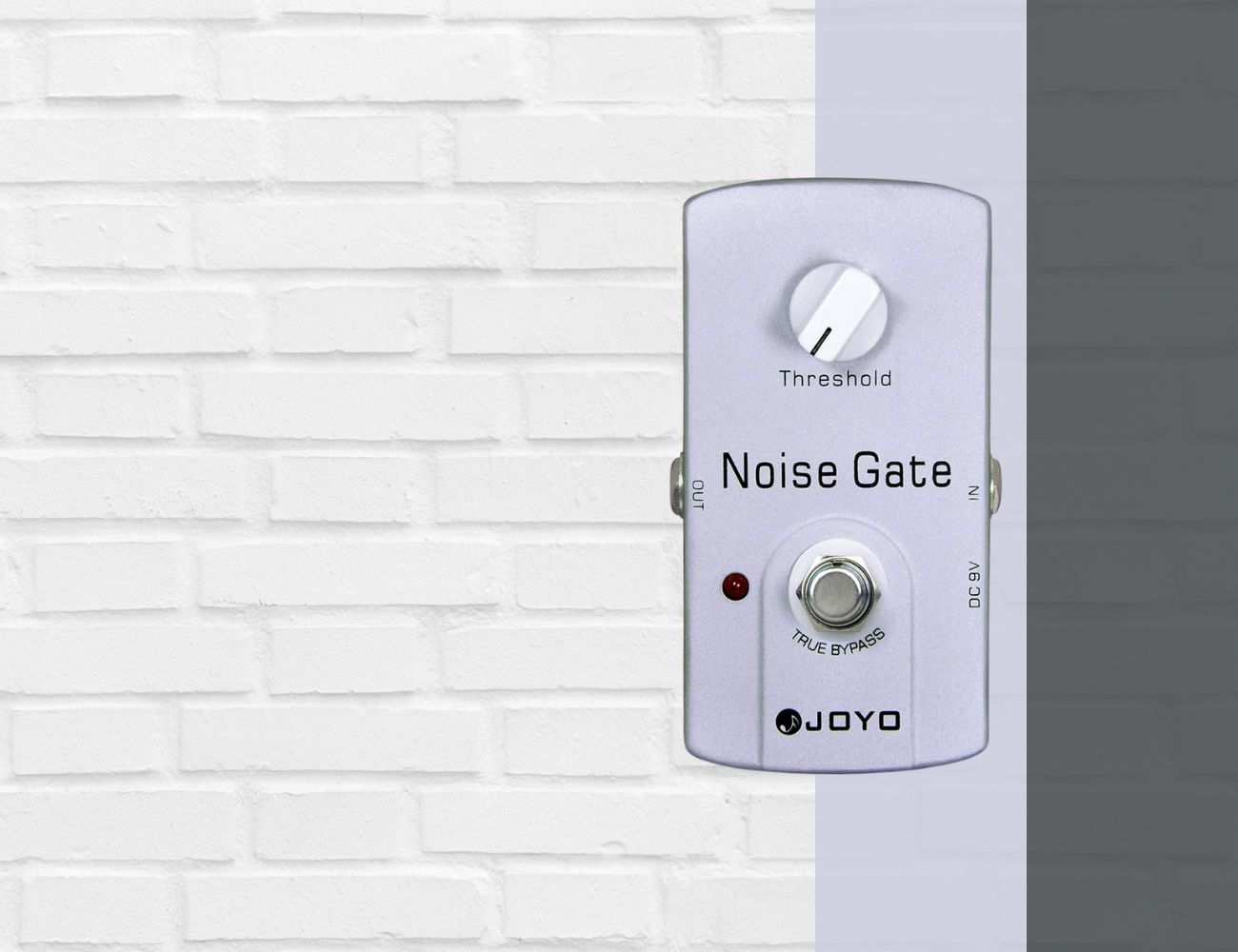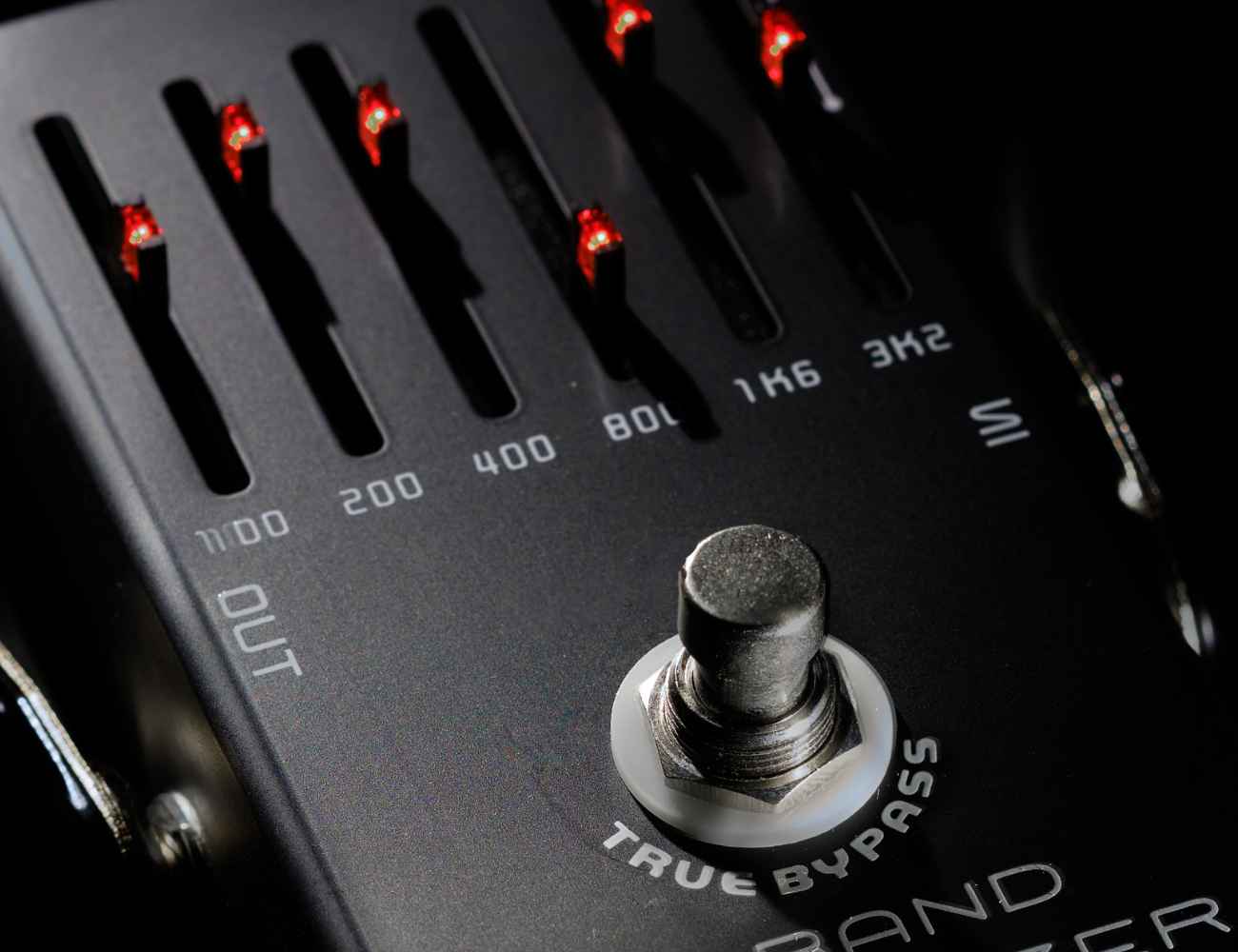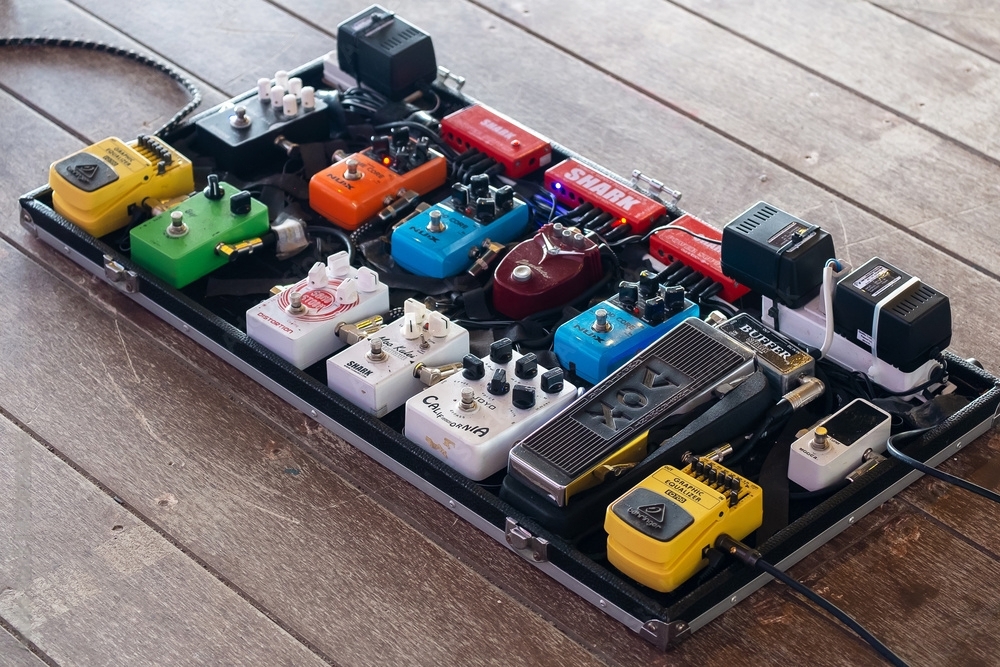So you’re in the middle of a killer jam session when suddenly, you need to switch from a clean tone to an overdriven, chorus-soaked sound.
You could fumble around with multiple pedals or have a powerful, all-in-one solution at your feet: a good and versatile guitar multi-effects pedal.
These gadgets offer tone options and effects combinations, making them an essential addition to any guitarist’s toolbox.
In this article, we’ll dive deep into these magical devices’ realm, exploring the market’s top picks and what makes them stand out from the crowd.
Whether you’re a beginner looking to streamline your setup or an advance player seeking new tone possibilities, this guide will help you find the perfect guitar multi-effects pedal to improve your playing even more.
Table of Contents
- Best Guitar Multi-Effects Pedals
- Boss GT-1000 Guitar Multi-Effects Pedals
- FLAMMA FX200 Multi-Effects Guitar Pedal
- Line 6 Helix Multi-Effects Guitar Pedal
- Zoom G11 Guitar Multi-Effects Processor
- Eventide H9 Harmonizer with Multi-Effects Pedal
- MOOER GE300 Multi-Effects Pedal
- TC Electronic PLETHORA X5 TonePrint Pedal Board
- Boss GT-1 Guitar Multi-Effects Pedal
- HeadRush Multi-Effects Pedal
- Zoom MS50G MultiStomp Guitar Pedal
- Mooer GE200 Multi-Effects Pedal
- NUX MG-400 Multi-Effects Pedal
- Boss GX-100 Guitar Multi-Effects Pedal
- Zoom G5n Guitar Multi-Effects with Expression Pedal
- Line 6 HX Stomp Multi-Effects Guitar Pedal
- What exactly is a guitar multi-effects pedal?
- What should you consider when choosing a guitar multi-effects pedal?
- How to properly use a guitar multi-effect pedal?
- How to order pedals on a pedalboard?
- Boutique vs. Mass-Produced pedals
- How much should you spend on a guitar pedal?
- Can you use a guitar pedal with a bass guitar?
- How to properly power your pedals?
Best Guitar Multi-Effects Pedals
Before I begin, here are my top selected choices:
Boss GT-1000 Guitar Multi-Effects Pedals

Powerful multi-fx pedal with AIRD Tube Logic technology and 116 effects. Check Price
|
|
Zoom MS50G MultiStomp Guitar Pedal

Powerful multi-effects and tones in a compact, easy to use pedal. Check Price
|
Boss GT-1000 Guitar Multi-Effects Pedals
Powerful multi-fx pedal with AIRD Tube Logic technology and 116 effects.
The BOSS GT-1000 is a powerful multi-fx pedal featuring AIRD Tube Logic technology, 116 effects, 10 footswitches, and an expression pedal. USB/Audio interface enables computer-based recording and editing. Comes with original tote bag.
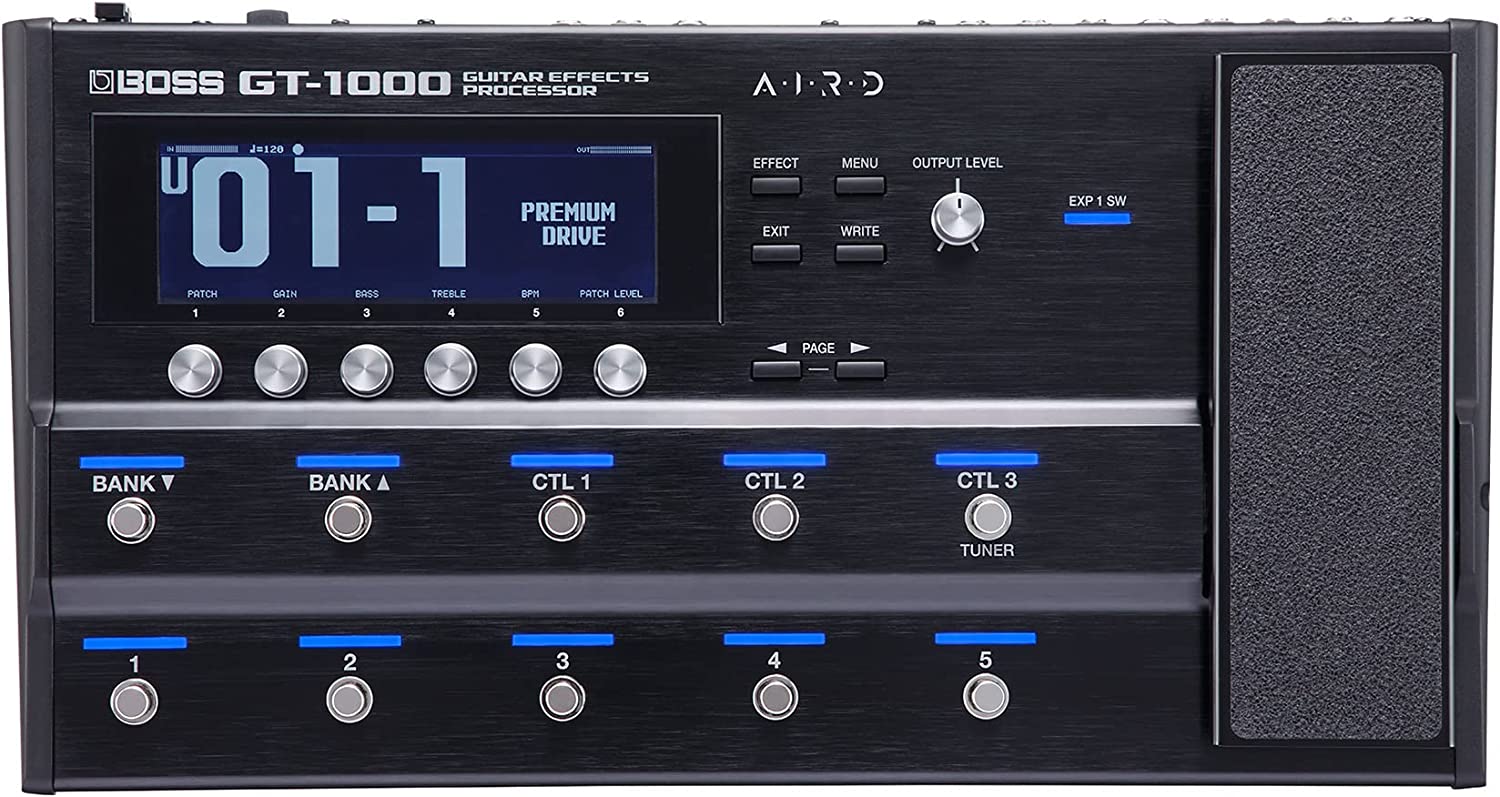
The Boss GT-1000 Guitar Multi-Effects is a versatile and powerful multi-effects pedal designed for guitarists seeking a wide array of high-quality sounds and effects.
With its advanced AIRD Tube Logic technology, the GT-1000 delivers exceptional sound quality and realism, emulating a variety of American and British amplifiers with impressive accuracy.
This multi-effects pedal offers 116 effects, including a comprehensive collection of Boss’s signature effects.
With ten footswitches and an expression pedal, users can easily navigate and control their sound, making it perfect for live performances, studio sessions, or home practice.
The GT-1000 also serves as a USB/audio interface, allowing for seamless computer-based recording and editing.
Moreover, this powerful pedal comes with an original tote bag for easy transportation.
Weighing 4.27 kilograms and operating at 9 volts and 300 milliamps, the Boss GT-1000 is a reliable and feature-packed tool for any guitarist’s arsenal.
- My Review
Having spent some quality time with the Boss GT-1000 Guitar Multi-Effects pedal, I’ve come to appreciate its wide range of features and capabilities.
Its advanced AIRD Tube Logic technology stands out, providing an incredibly realistic emulation of classic American and British amplifiers.
This powerful technology ensures you can find the perfect amp sound to suit your needs regardless of your preferred music style or genre.
Navigating through the 116 available effects is a breeze, thanks to the ten footswitches and expression pedal.
From the iconic sounds of Boss’s back catalog to new and inspiring effects, there’s no shortage of creative possibilities with the GT-1000.
The pedal also serves as a USB/audio interface, making recording and editing your guitar tracks on a computer easy – a feature I found extremely useful for home and studio setups.
One thing to consider, however, is that the GT-1000 might be a bit complex for beginners.
With many effects and parameters at your disposal, it can be overwhelming for those new to multi-effects pedals.
But, if you’re willing to spend time and effort exploring its capabilities, the rewards are immense.
Another aspect worth mentioning is the expression pedal’s relatively short travel.
While it doesn’t affect the pedal’s performance significantly, some players might prefer a longer journey for more precise control.
Additionally, a few users have reported some noise issues, which could be an isolated issue or due to the specific setup used.
Here are the ratings I’ll give to the Boss GT-1000 Guitar Multi-Effects Pedals:
The Boss GT-1000 is a feature-rich and versatile multi-effects pedal that delivers exceptional sound quality and a wide range of creative possibilities.
Whether you’re playing live, in the studio, or practicing at home, the GT-1000 is an invaluable addition to any guitarist’s gear collection.
- Pros:
- Advanced AIRD Tube Logic technology.
- 116 diverse effects available.
- USB/audio interface for recording/editing.
- Cons:
- May be complex for beginners.
- Short expression pedal travel.
- Potential noise issues.
My final verdict is that the Boss GT-1000 Guitar Multi-Effects pedal is an outstanding gear for guitarists seeking versatility, advanced features, and top-notch sound quality.
Its impressive AIRD Tube Logic technology, extensive range of effects, and user-friendly interface make it a valuable addition to any musician’s arsenal.
While there might be a slight learning curve for beginners, the GT-1000 is undoubtedly worth the investment for those looking to elevate their guitar-playing experience.
FLAMMA FX200 Multi-Effects Guitar Pedal
FLAMMA FX200: Multi Effects Pedal with 5” LCD Touchscreen, Extensive I/O, and more.
The FX200 multi-effects pedal from Flamma features a 5” touch screen, easy software editing, adjustable effects chain, 30 cabinet simulations, 4 footswitches, programmable MIDI port, and expanded I/O for all your music needs. Plug and play with presets, or customize your sound with auxiliary in, expression pedal, stereo FX Loop, and more.
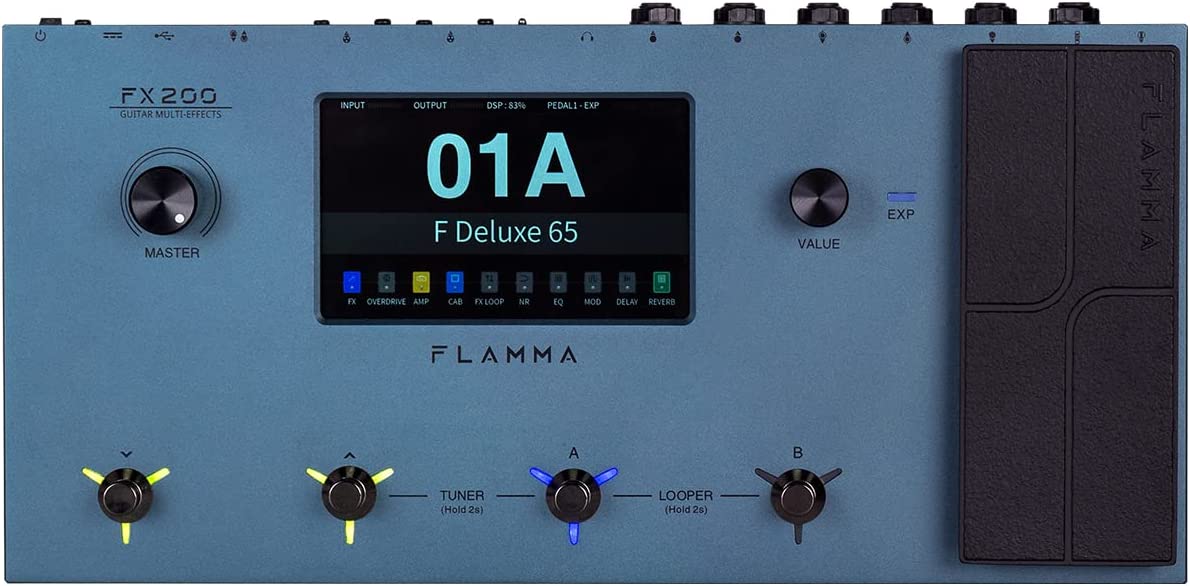
The FLAMMA FX200 is a multi-effects guitar pedal providing various customizable sound options for guitarists.
Featuring a 5-inch LCD touchscreen, this pedal makes it easy for users to navigate the various settings and adjust their sound according to their preferences.
With ten effects modules and 160 different types of effects, the FX200 offers a diverse range of options for users to explore.
One of the standout features of this guitar pedal is its editable effects chain, which allows musicians to change the order of the modules to create their ideal sound.
The pedal also boasts an extensive input/output (I/O) system, making it versatile for studio, live performance, or practice settings.
The FX200 comes with 58 built-in preamp models and 30 high-quality cabinet simulations, enabling users to recreate the feel of an authentic tube amplifier.
Additional features include 80 drum machine variations, ten metronome styles, and a 52-second looper, providing guitarists with a comprehensive suite of tools to enhance their playing experience.
- My Review
Having thoroughly explored the FLAMMA FX200 Multi-Effects Guitar Pedal, I can confidently say that it offers a diverse range of sound options for guitarists of all skill levels.
Furthermore, the 5-inch LCD touchscreen is visually appealing and incredibly user-friendly, making it easy for me to navigate the various settings and adjust my sound accordingly.
One aspect that truly impressed me was the editable effects chain, which allowed me to change the order of the modules and create a unique sound tailored to my preferences.
With ten effects modules and 160 different types of effects, I found myself spoiled for choice as I experimented with various combinations and settings.
The extensive input/output (I/O) system proved quite versatile, and I appreciated its flexibility in adapting to different situations – whether practicing at home, jamming with friends, or performing live on stage.
In addition, the 58 built-in preamp models and 30 high-quality cabinet simulations added another layer of authenticity to my sound, successfully emulating the feel of a tube amplifier.
During my time with the FX200, I also enjoyed exploring the 80 drum machine variations and ten metronome styles, which were valuable tools for enhancing my practice sessions.
In addition, the built-in 52-second looper was a delightful addition, allowing me to layer sounds and create richer musical textures.
However, I encountered a few minor issues, such as the input headroom being somewhat limited, occasionally leading to distortion in clean sounds.
Additionally, the expression pedal settings could be slightly more intuitive, and the pedal might benefit from including a physical manual for users who prefer a tangible guide.
Here are the ratings I’ll give to the FLAMMA FX200 Multi-Effects Guitar Pedal:
Despite these minor drawbacks, I found the FLAMMA FX200 a fantastic investment for any guitarist looking to expand their sonic palette.
Its wide range of features, user-friendly interface, and impressive sound quality make it a valuable addition to any guitarist’s collection.
- Pros:
- Wide range of sound options.
- User-friendly LCD touch screen.
- Versatile input/output system.
- Cons:
- Limited input headroom.
- Expression pedal settings issues.
- No physical manual included.
My final verdict is that the FLAMMA FX200 Multi Effects Guitar Pedal is a valuable and versatile tool for any guitarist looking to expand their sonic capabilities.
Its wide range of features, user-friendly interface, and impressive sound quality offer great value for its price.
Despite minor drawbacks, the pedal stands out as a solid investment for musicians seeking to enhance their playing experience.
Line 6 Helix Multi-Effects Guitar Pedal
Premium multi-effects with intuitive control and precision sound.
The Helix multi-effects guitar pedal offers a powerful processor with intuitive controls, a hi-res LCD display, and built-in USB audio interface for recording. It also features a stereo XLR output for direct PA connection.
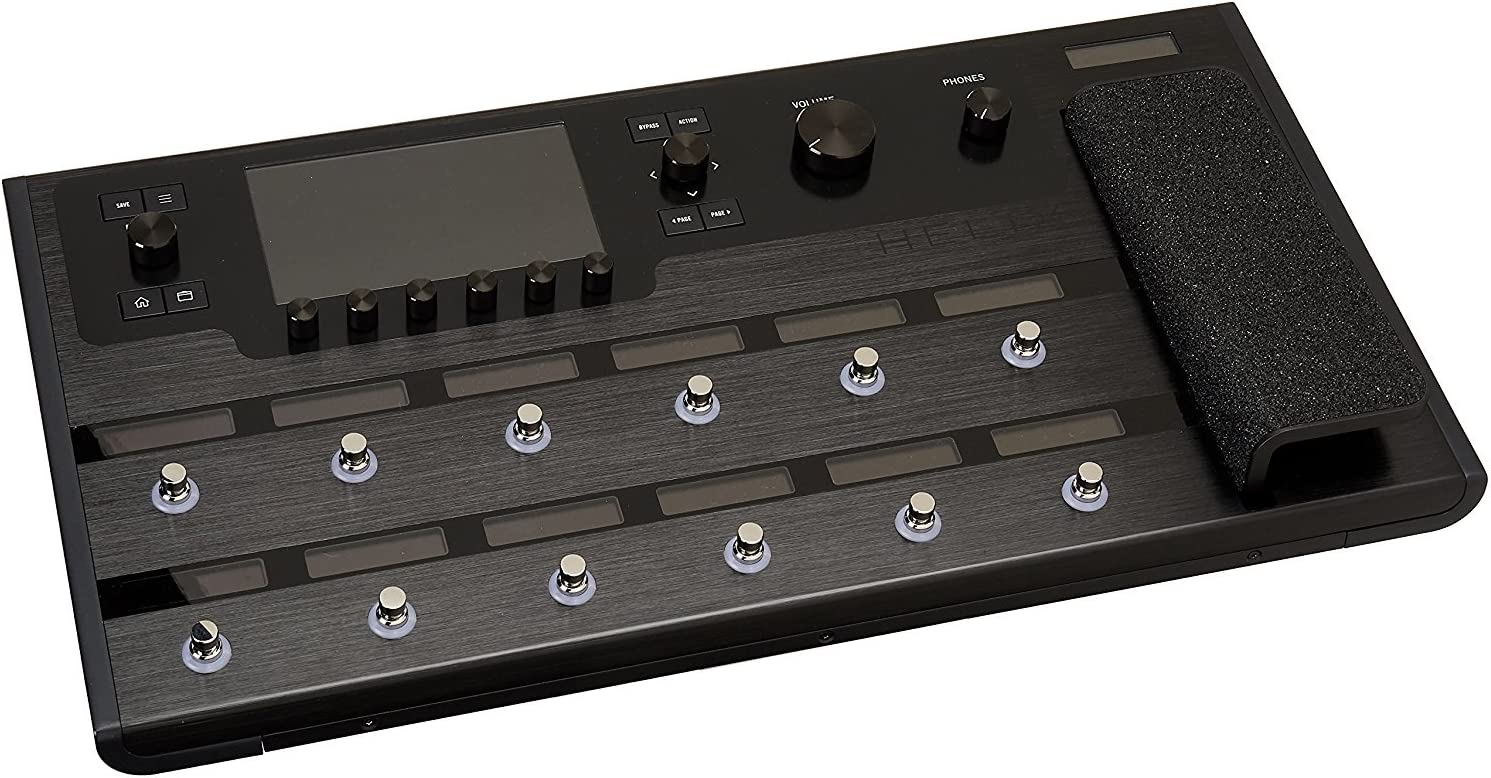
The Line 6 Helix Guitar Pedal is an all-in-one solution for guitarists seeking various effects and amp modeling options.
This multi-effects pedal is powered by a dual DSP HX modeling engine, which delivers four separate stereo signal paths, allowing for complex sound combinations and ultimate versatility.
You’ll have no shortage of creative possibilities with 45 amplifier models, 30 cabinet models, 16 microphone models, and 70 effects.
One of the standout features of this pedal is its ability to import third-party impulse response files, further expanding the range of available tones.
In addition, the pedal’s 12 capacitive-sensing footswitches and customizable scribble strips make it easy to edit, assign, and engage effects on the fly.
At the same time, the hands-free Pedal Edit mode simplifies effect parameter adjustments.
The Line 6 Helix is not just about effects; it supports up to three expression pedals and offers CV/Expression outputs for even more control.
With a robust build quality and sleek black design, this pedal is a reliable and powerful addition to any guitarist’s arsenal.
- My Review
Upon unboxing the Line 6 Helix Multi-Effects Guitar Pedal, I was immediately impressed by its sleek black design and solid build quality.
I eagerly plugged it in and explored the vast array of effects and amp models.
The dual DSP-powered HX modeling engine provided four separate stereo signal paths, giving me the flexibility to craft intricate and creative soundscapes.
Diving into the 45 amplifier models, 30 cabinet models, 16 microphone models, and 70 effects, I found the sound quality exceptional, with rich and authentic tones that closely resembled their analog counterparts.
The clean sounds were especially impressive, offering a pristine clarity that shone through.
However, I did notice a bit of hum when using some of the distortion effects, which could be rectified with a noise gate, but it’s something to be aware of.
The ability to import third-party impulse response files was a game-changer, allowing me to customize further and fine-tune my sound.
In addition, the 12 capacitive-sensing footswitches and customizable scribble strips made editing, assigning and engaging effects on the fly easy.
I also appreciated the hands-free Pedal Edit mode, which streamlined the process of tweaking effect parameters.
While the Line 6 Helix is undoubtedly feature-packed, it can initially be overwhelming.
There’s a bit of a learning curve involved in fully mastering this pedal, but with some patience and practice, I found it to be a rewarding and inspiring tool.
The only real downside I encountered was the less-than-stellar software experience on Windows, but that didn’t detract too much from the overall value of the pedal itself.
Here are the ratings I’ll give to the Line 6 Helix Multi-Effects Guitar Pedal:
In my experience, the Line 6 Helix Multi-Effects Guitar Pedal is an incredibly powerful and versatile gear piece that can elevate a guitarist’s sonic palette.
While it may have a few minor drawbacks and a steep learning curve, the benefits of this pedal far outweigh any negatives, making it a worthwhile investment for discerning musicians.
- Pros:
- Exceptional sound quality.
- Highly versatile and customizable.
- Sturdy build and sleek design.
- Cons:
- Steep learning curve.
- Hum on some distortion effects.
- Software issues on Windows.
My final verdict is that the Line 6 Helix Multi-Effects Guitar Pedal is an outstanding piece of gear, offering exceptional versatility and a wide range of high-quality features.
Despite minor drawbacks and a learning curve, the overall tone, performance, and value make it a worthwhile investment for serious musicians.
Zoom G11 Guitar Multi-Effects Processor
Zoom G11: Multi-effects, amp modeling, looper with expression pedal.
The Zoom G11 offers over 30 years of guitar processing in one device, with new amp models, effects, cabinet emulations, 70 preloaded IRs and a touchscreen interface for creative freedom. Zoom’s mission is to provide easy-to-use tools for creative expression.
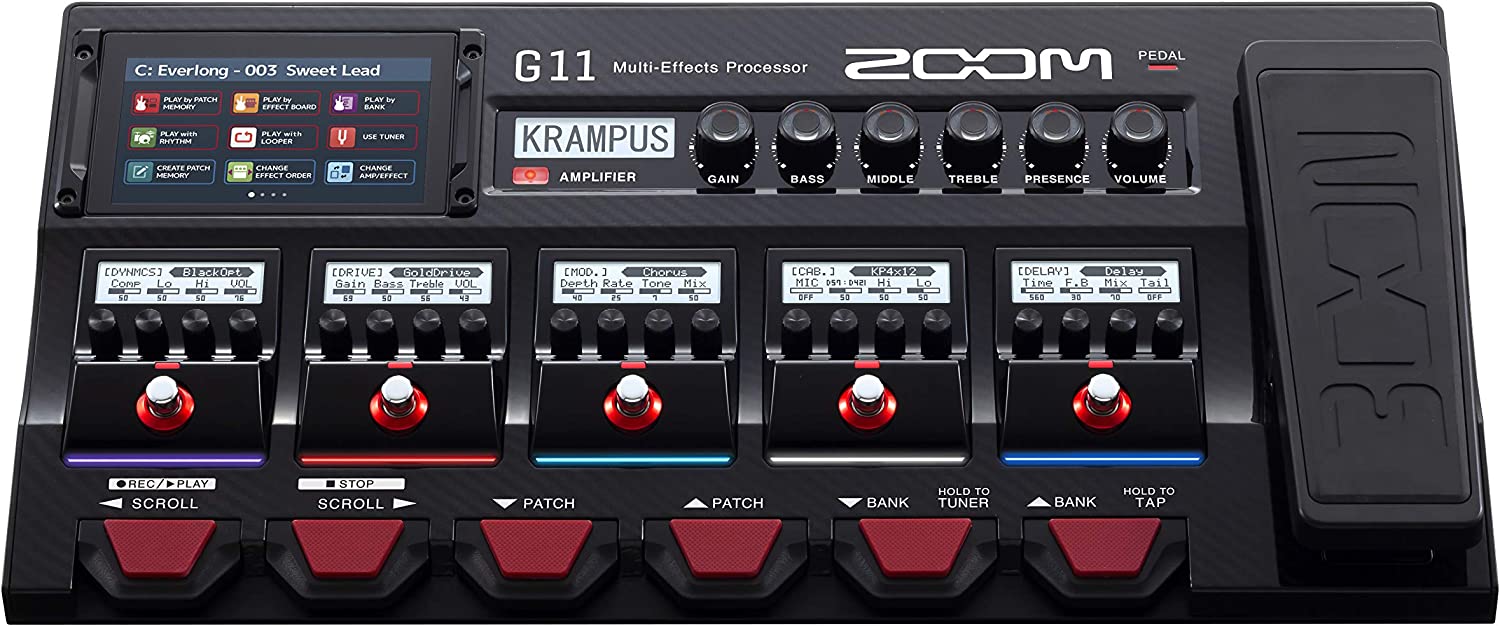
The Zoom G11 is a versatile guitar multi-effects processor with an expression pedal and a user-friendly touchscreen interface.
This all-in-one unit boasts a wide range of features, including over 100 built-in effects, amp modeling, impulse response (IR), a looper, and a direct audio interface for seamless recording to your computer.
This powerful processor offers new Zoom amp models that emulate the tonal qualities of classic amps, as well as fresh distortion and modulation effects.
Additionally, the Zoom G11 has 22 cabinet emulations, 70 preloaded impulse responses, and 130 user slots for custom IRs.
The device includes five stomp switches, an expression/volume control, a five-minute looper, and 68 rhythm patterns to help you craft the perfect sound.
Weighing in at just 9 pounds, this compact and lightweight processor is designed to let your creativity soar, whether you’re a professional musician or a casual hobbyist.
With the Zoom G11, you’ll have everything you need to achieve a wide range of guitar tones and effects in one convenient package.
- My Review
Having personally experienced the Zoom G11 Guitar Multi-Effects Processor, I can confidently say that this device is a game-changer for guitarists looking for a versatile and user-friendly effects unit.
The touchscreen interface is incredibly intuitive, making navigating the vast array of options and settings easy.
In addition, though it’s packed with features, it’s surprisingly lightweight and compact, so it won’t weigh you down during gigs or practice sessions.
One of the standout aspects of the G11 is its impressive selection of new Zoom amp models and distortion and modulation effects.
With over 100 built-in effects, you’ll have no trouble finding the perfect sound for your playing style.
In addition, the amp modeling is top-notch, providing an authentic tone that mimics the warmth and character of classic amps.
The unit’s 22 cabinet emulations and 70 preloaded impulse responses offer a wealth of options for shaping your tone, and the 130-user slots allow for plenty of customization.
The five stomp switches and expression/volume control give you hands-on control over your sound, while the five-minute looper and 68 rhythm patterns inspire creativity and enhance practice sessions.
One minor drawback I noticed is the slightly slow boot-up time, taking around 45 seconds to get going.
However, this is a small inconvenience when considering the G11’s overall performance and capabilities.
Despite its plastic construction, the G11 feels durable and well-built.
It may not have the solid metal feel of some competitors, but it holds its own in terms of functionality and ease of use.
The only other improvement I can suggest would be the addition of XLR outputs for easier integration with sound systems.
However, this can be easily resolved with a DI box.
Here are the ratings I’ll give to the Zoom G11 Guitar Multi-Effects Processor:
In my experience, the Zoom G11 is a fantastic multi-effects processor that caters to guitarists of all skill levels.
Its user-friendly design, extensive features, and excellent sound quality make it a valuable addition to any guitarist’s setup.
- Pros:
- User-friendly touchscreen interface.
- Wide variety of effects and amp models.
- Compact and lightweight design.
- Cons:
- Slow boot-up time.
- Plastic construction.
- No XLR outputs.
My final verdict is that the Zoom G11 Guitar Multi-Effects Processor is a highly versatile and feature-rich device with outstanding tone and performance.
The user-friendly touchscreen interface, combined with the extensive range of effects and amp models, make it a valuable addition to any guitarist’s setup.
Despite a few minor drawbacks, such as slow boot-up time and plastic construction, the overall value of this product is impressive, making it a worthwhile investment for musicians of all skill levels.
Eventide H9 Harmonizer with Multi-Effects Pedal
Eventide H9 Harmonizer Pedal: 9 effects, 99 presets, wireless Bluetooth control.
The Eventide H9 offers a one-knob user interface and wireless Bluetooth connection, allowing you to easily manage and purchase new effects. It comes with stereo audio I/O, MIDI, expression pedal, and auxiliary switch inputs.
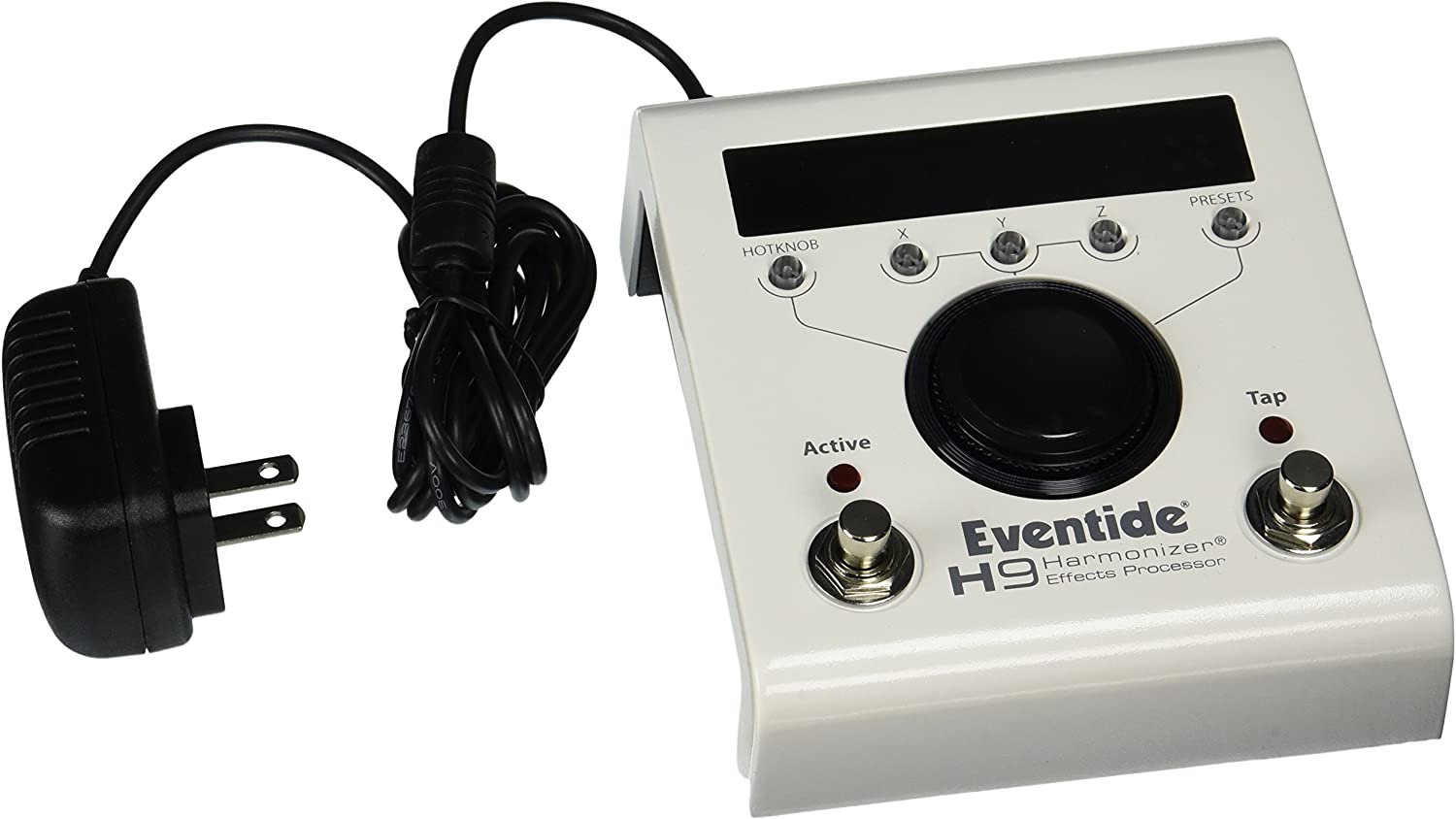
The Eventide H9 Harmonizer Pedal is an impressive effects pedal packed with various audio effects, making it a go-to choice for musicians and recording engineers.
This pedal offers nine effect algorithms and 99 presets, catering to various spatial effects like reverb delays and one-of-a-kind combination effects.
In addition, it boasts true analog bypass and supports MIDI via DIN and USB.
A standout feature of the H9 Harmonizer is its compatibility with Eventide’s stompbox effects, providing users with an extensive collection of high-quality sounds.
Additionally, the pedal can be easily controlled through its front panel or wirelessly via Bluetooth using the free H9 Control app on iOS devices.
This app allows live editing, preset management, and system settings adjustments.
With its user-friendly interface and an impressive selection of effects, the Eventide H9 Harmonizer Pedal is an excellent choice for musicians looking to enhance their sound with a reliable and versatile effects pedal.
- My Review
After spending some quality time with the Eventide H9 Harmonizer Pedal, I have to say that this versatile piece of gear has blown me away.
Packing a wide array of high-quality effects into a compact and user-friendly package, it’s a game-changer for musicians and recording engineers.
One of the most impressive aspects of the H9 Harmonizer is the sheer number of effects it offers.
With nine effect algorithms and 99 presets, I have an entire Sonic toolbox at my fingertips.
The spatial effects, including reverbs, delays, and unique combination effects, add depth and dimension to any sound that passes through it.
The true analog bypass ensures that the signal remains pristine, while the MIDI capabilities via DIN and USB make it easy to integrate the pedal into any setup.
I appreciate the simplicity of the one-knob user interface, which makes it accessible even for those who may be new to using effects pedals.
However, the magic happens when connecting the H9 Harmonizer to an iOS device using the free H9 Control app.
The app allows for live editing, preset management, and system settings adjustments, all wirelessly via Bluetooth.
This level of control and customization is unparalleled in other pedals I’ve used, making the H9 a standout in its class.
That being said, the pedal does have a few minor drawbacks.
For instance, it can only run one effect algorithm at a time, limiting its flexibility in certain situations.
Additionally, the pedal requires an iOS device for optimal use, which may not be ideal for some users.
Here are the ratings I’ll give to the Eventide H9 Harmonizer with Multi-Effects Pedal:
In my experience, the Eventide H9 Harmonizer Pedal offers top-notch effects, a user-friendly interface, and seamless integration with iOS devices.
While it has a few limitations, this pedal’s overall performance and sound quality make it a worthy investment for musicians seeking a versatile and powerful effects solution.
- Pros:
- Vast array of effects and algorithms.
- Wireless control via iOS app.
- Compact and durable design.
- Cons:
- Expensive additional algorithm purchases.
- Hardware issues reported by users.
- Only one effect usable at a time.
My final verdict is that the Eventide H9 Harmonizer Pedal offers a wide variety of high-quality effects and algorithms and convenient wireless control via its iOS app.
However, the additional algorithm costs and some reported hardware issues may make it less appealing for those on a budget or who require multiple effects simultaneously.
Overall, it’s a powerful and versatile pedal with some minor drawbacks.
MOOER GE300 Multi-Effects Pedal
Create professional guitar tones with MOOER’s GE300 Lite amp modelling and effects processor.
The MOOER GE300 Lite is a comprehensive multi-effects processor for guitarists, boasting 108 digital amp models, 43 factory cab sims, an IR loader, and a variety of classic and modern effects. It is easily expandable with MOOER’s GE-Labs and MOOER Studio platforms, and features a variety of connection options for easy tone creation.
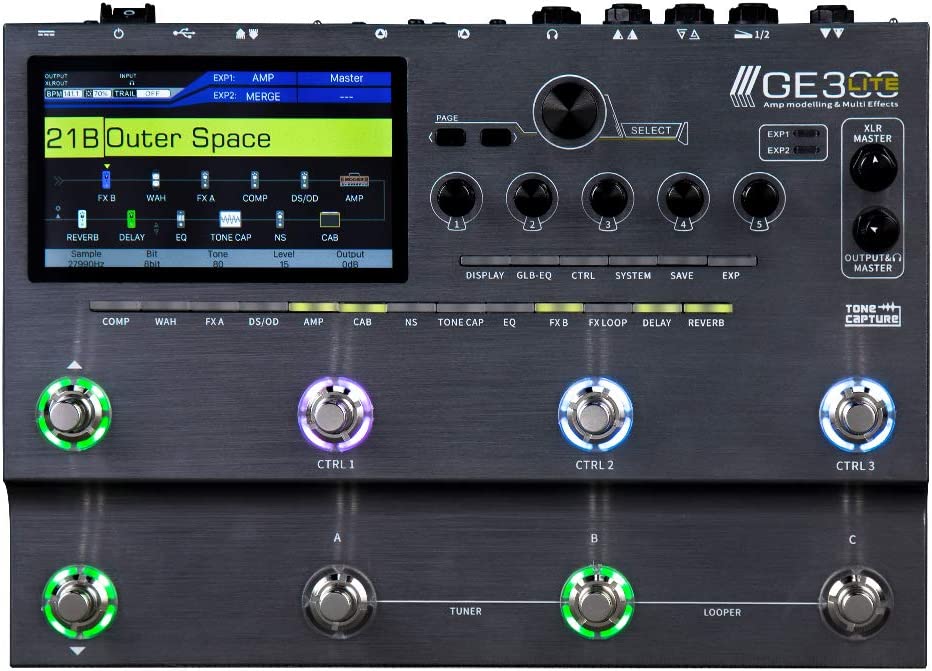
The MOOER GE300 Lite is a versatile guitar amp modeling and multi-effects processor designed for live performances and studio recording.
This compact device comprises 108 preamp models that capture the essence of real-life amplifiers, 164 high-quality effects, and 43 IR-based factory speaker cab models.
In addition, you can further expand your tonal possibilities with support for third-party impulse response files.
One of the standout features of this processor is its Tone Capture function, which allows you to sample and create digital sound models from your amplifiers, stompboxes, guitars, or cabinets.
In addition, the programmable FX LOOP provides easy integration of your favorite effects and flexibility for four cable methods and stereo amp setups.
The GE300 Lite also features intuitive and user-friendly controls for creating and editing tone presets.
It has MIDI in/out/thru capabilities, stereo outputs (1/4″ and XLR), and supports up to two external expression pedals.
Additionally, the device has a high-precision, adjustable tuner and a 30-second stereo loop station to enhance your playing experience.
- My Review
I recently had the opportunity to try out the MOOER GE300 Lite Guitar Amp Modelling Multi-Effects Processor, and I must say, it was quite the experience.
This compact, all-in-one unit offers many features that cater to both stage and studio performances.
Upon unboxing this little powerhouse, I was immediately impressed by its build quality and sleek design.
However, when I dove into its features, I discovered an extensive collection of 108 preamp models, 164 high-quality effects, and 43 IR-based factory speaker cab models.
With such a wide range of options, it felt like having the ultimate toolbox of tones at my fingertips.
The GE300 Lite’s non-linear digital amp modeling technology and IR-based speaker cab models gave me an authentic, tube-like feel and dynamic response.
In addition, the Tone Capture feature allowed me to sample and create digital sound models of my real-life amplifier, stompbox, and guitar – talk about versatility!
One aspect I found particularly useful was the programmable FX LOOP, which made integrating my favorite effects a breeze.
The stereo outputs, MIDI connectivity, and support for two external expression pedals further increased the unit’s flexibility.
Though I was mostly pleased with my experience, I found that the pitch shifter effect could improve.
Additionally, the software had a few quirks and could benefit from an update.
Here are the ratings I’ll give to the MOOER GE300 Multi-Effects Pedal:
Despite these minor drawbacks, I believe the MOOER GE300 Lite is a fantastic choice for guitarists seeking an all-encompassing solution for their tone needs.
Its ease of use, variety of features, and compact size make it a valuable addition to any musician’s arsenal.
- Pros:
- Extensive amp models and effects.
- Compact, sleek design.
- Flexible connectivity options.
- Cons:
- Needs improvement in pitch shifter.
- Software quirks and update required.
- Minor learning curve for UI.
My final verdict is that the MOOER GE300 Lite Guitar Amp Modelling Multi-Effects Processor is a highly versatile and feature-rich device offering great tone and performance at a competitive price.
Its few drawbacks are greatly outweighed by its overall quality, making it a solid choice for guitarists seeking a comprehensive and compact solution for their tone needs.
TC Electronic PLETHORA X5 TonePrint Pedal Board
Create, customize, and mix up to 127 TonePrint pedal boards with 5 MASH footswitches.
Plethora X5 is a TonePrint pedal board with 5 MASH footswitches, allowing you to create up to 127 custom boards with any combination of TC TonePrint pedals. It features an FX insert loop for external drive pedals, an EXP input for expression pedal control, and a Quick Swap feature for easy experimentation with pedal routing. Bluetooth connectivity lets you control it with the TonePrint app.
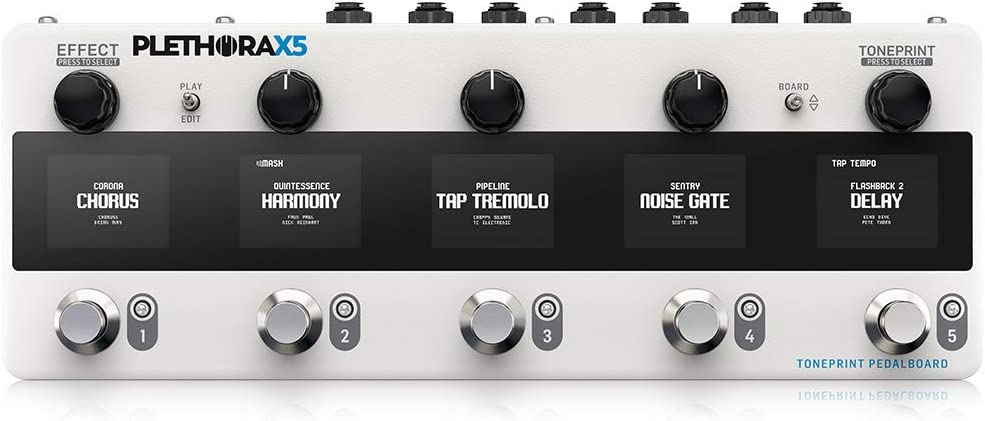
The TC Electronic PLETHORA X5 is a highly flexible and intuitive pedal board designed for guitar enthusiasts seeking various effects and customization options.
With the ability to create and store up to 127 custom boards, users can mix and match any combination of TonePrint pedals to achieve their desired sound.
Each board can hold up to five pedals and store up to 75 TonePrints per effect for quick access.
Some of the included effects are Hall of Fame 2 Reverb, Flashback 2 Delay, Sub n Up Octaver, Brainwaves Pitch Shifter, Corona Chorus, Hypergravity Compressor, Mimiq Doubler, Vortex Flanger, Pipeline Tap Tremolo, Quintessence Harmony, Sentry Noise Gate, and Shaker Vibrato.
In addition, the pedal board features simple, easy-to-use controls, making it accessible to beginners and experienced musicians.
The PLETHORA X5 is constructed with a sleek design featuring silver, white, and black colors.
It measures 11.73 x 4.57 x 2.09 inches and weighs 1400 grams, making it a compact and portable option for guitarists.
With a voltage of 9 volts, this pedal board is powerful and efficient.
- My Review
Having spent considerable time with the TC Electronic PLETHORA X5 TonePrint Pedal Board, I’ve come to appreciate its versatility and convenience.
Creating and storing up to 127 custom boards with various combinations of TonePrint pedals is a real game-changer.
I experimented with different pedal arrangements, and the ease of use encouraged me to explore new tonal possibilities.
The range of effects available, from the Hall of Fame 2 Reverb and Flashback 2 Delay to the Quintessence Harmony and Shaker Vibrato, is impressive.
Each effect delivers high-quality sound, and the option to store up to 75 TonePrints per effect allows me to fine-tune my setup to match my personal preferences.
One aspect that stands out is the pedal board’s intuitive controls.
Even with minimal documentation, the PLETHORA X5 is surprisingly easy to navigate.
The compact design is another plus, making it a portable option for guitarists on the go.
However, it’s worth noting that the PLETHORA X5 focuses on modulation effects and does not include overdrive or distortion pedals, which may be a drawback for some users.
Additionally, the build quality, particularly the small LCD screens, could be improved to match the overall performance of the pedal board.
The PLETHORA X5 is a fantastic option for those looking to expand their sonic palette with a wide range of high-quality effects.
Here are the ratings I’ll give to the TC Electronic PLETHORA X5 TonePrint Pedal Board:
In addition, the pedal board’s flexibility and user-friendly interface make it enjoyable while encouraging creativity and experimentation.
Despite its limitations, the PLETHORA X5 is valuable to any guitarist’s rig, offering countless tonal possibilities and a streamlined, convenient setup.
- Pros:
- Wide range of high-quality effects.
- Highly customizable with 127 custom boards.
- User-friendly interface and controls.
- Cons:
- No overdrive or distortion effects.
- Small LCD screens seem low quality.
- Build quality could be improved.
My final verdict is that the TC Electronic PLETHORA X5 TonePrint Pedal Board is a versatile and feature-packed option for guitarists seeking a wide range of high-quality effects in a user-friendly and customizable platform.
Despite minor drawbacks in build quality and the absence of overdrive or distortion effects, the PLETHORA X5’s performance, brand reputation, and overall value make it a worthy addition to any guitarist’s rig.
Boss GT-1 Guitar Multi-Effects Pedal
Premium sound, ultra-portable, intuitive control.
BOSS GT-1 is an ultra-portable, easy-to-use multi-effects processor offering pro-level tones, intuitive sound creation and real-time effects adjustment. Powered by the powerful BOSS GT-series engine and offering access to a huge selection of amps and effects, it is the ideal choice for musicians on the go.
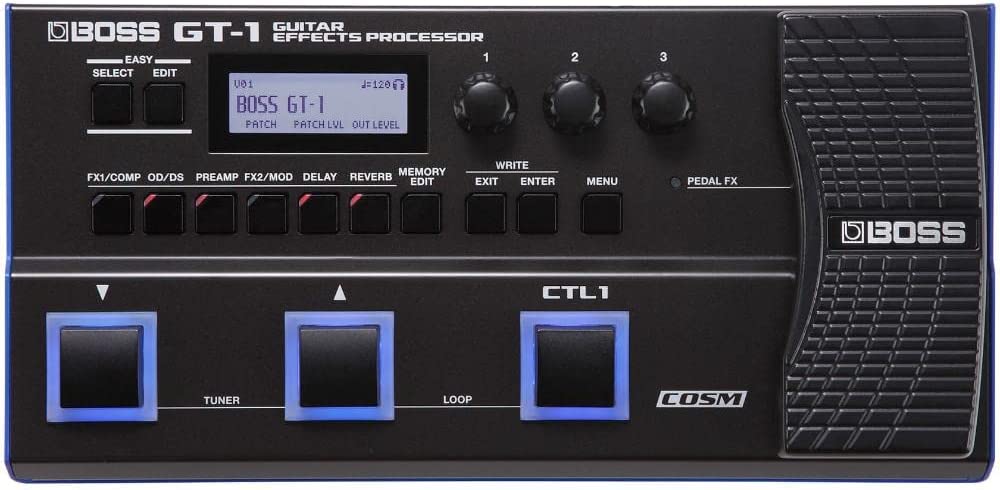
The Boss GT-1 Guitar Multi-Effects Pedal is a versatile and portable device designed for guitarists of all levels.
This compact pedal boasts 108 effects and 198 patches, offering a wide range of tones and sound-shaping capabilities.
In addition, its lightweight design and durable construction make it easy to carry in a guitar bag, perfect for musicians on the go.
Powered by the renowned Boss GT-series engine, the GT-1 provides exceptional sound quality and access to numerous world-class amps and effects.
Its user-friendly interface allows for quick and easy sound creation, while an assignable control switch and expression pedal enable dynamic real-time effects adjustments.
Ideal for live performances and recording sessions, the Boss GT-1 can be powered by AC or battery, offering flexibility in various situations.
Additionally, by connecting to Boss Tone Central, users can download free pro patches, editing software, and more, further enhancing the capabilities of this impressive multi-effects pedal.
- My Review
I recently enjoyed trying out the Boss GT-1 Guitar Multi-Effects Pedal, which was quite an experience.
This compact, lightweight device managed to pack a serious punch with 108 effects and 198 patches, offering a wide variety of tones to play around with.
In addition, the powerful Boss GT-series engine ensures high-quality sound and access to numerous world-class amps and effects, making it suitable for all types of music.
Navigating through the GT-1’s interface was a breeze, allowing for quick and effortless sound creation.
I particularly appreciated the assignable control switch and expression pedal, which provided dynamic real-time effects adjustments during my jam sessions.
In addition, the pedal’s design is visually appealing and durable, ensuring it can withstand the hustle and bustle of a musician’s lifestyle.
One feature that stood out to me was the ability to connect to Boss Tone Central, where I could download free pro patches, editing software, and more.
This added a new dimension to the pedal’s capabilities, allowing me to explore further and customize my sound.
In addition, the GT-1 can be powered by AC or battery, making it all the more convenient for use in various situations.
Despite the numerous features and capabilities, I did encounter a slight learning curve when getting acquainted with the pedal.
It took some time to understand and make the most of its features fully, but the results were worth the effort once I did.
Here are the ratings I’ll give to the Boss GT-1 Guitar Multi-Effects Pedal:
In my experience, the Boss GT-1 Guitar Multi-Effects Pedal is a fantastic device for guitarists seeking versatility, portability, and exceptional sound quality.
While it may require some patience and experimentation to grasp its potential fully, the result is a powerful and dynamic tool that can enhance any guitarist’s sonic arsenal.
- Pros:
- Versatile with 108 effects and 198 patches.
- Portable, lightweight, and durable design.
- Access to Boss Tone Central resources.
- Cons:
- Initial learning curve for beginners.
- Power adapter not included.
- Can be complicated for simple use cases.
My final verdict is that the Boss GT-1 Guitar Multi-Effects Pedal is a highly versatile and feature-packed device that delivers exceptional tone and performance, making it a valuable addition to any guitarist’s gear collection.
With the backing of a reputable brand like Boss, it’s hard to go wrong with this pedal.
HeadRush Multi-Effects Pedal
Unlock tones with HeadRush Pedalboard’s custom-designed DSP, 7″ touch display, expression pedal and more.
HeadRush Pedalboard offers realistic amp, cabinet, microphone, and FX models with a 7″ touch display, expression pedals, 12 footswitches, 4 amp switching, USB audio interface, and FX loop for ultimate guitar tone-sculpting capability.
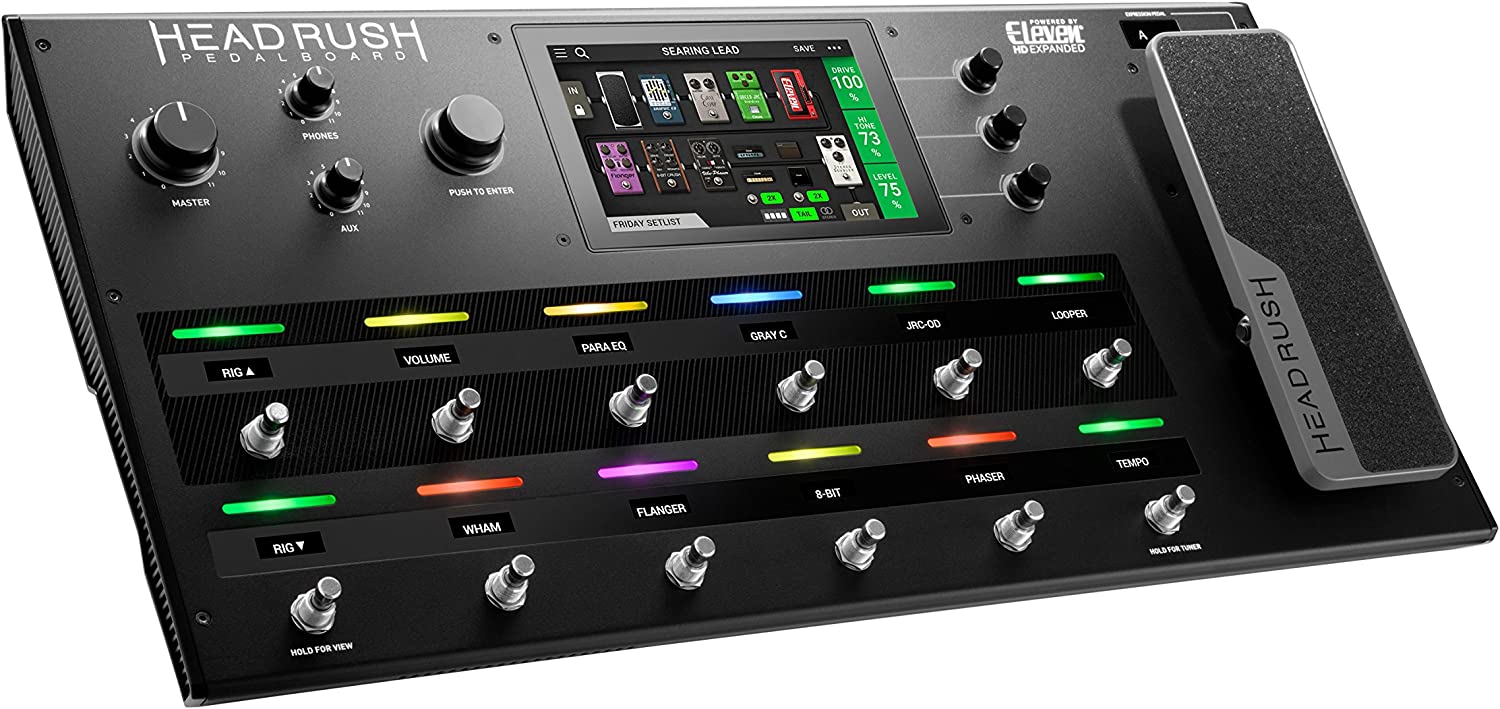
The HeadRush Pedalboard is a guitar amp and FX modeling processor designed for guitarists looking to craft their signature sound.
Powered by a custom-designed quad-core DSP system with Eleven HD Expanded DSP software, it offers a wide range of realistic amps, cabinets, microphones, and effects models for unlimited tone-sculpting capabilities.
The 7-inch high-resolution touchscreen display allows easy rig creation and editing, while the steel chassis ensures durability and houses an integrated cable channel organizer.
A standout feature of this pedalboard is the gapless preset switching with reverb/delay tail spillover, along with a built-in looper that offers up to 20 minutes of recording time.
It also supports USB connectivity for loading custom impulse response files and provides studio-grade recording and ramping capabilities up to 24-bit/96KHz. So whether performing live or recording in the studio, the HeadRush Pedalboard aims to deliver versatility, ease of use, and exceptional sound quality.
- My Review
From the moment I unpacked the HeadRush Pedalboard, I could sense the potential of this powerful guitar amp and FX modeling processor.
The solid steel chassis and high-resolution 7-inch touchscreen display immediately stood out, offering both durability and ease of use for creating and editing rigs on the fly.
After diving into the presets, I found some didn’t quite meet my expectations.
However, building my rigs from scratch was an entirely different story.
The vast array of amp, cab, mic, and effects models the Eleven HD Expanded DSP software provided allowed me to craft unique tones that captured my signature sound.
In addition, the interface was incredibly intuitive, making it easy to experiment and fine-tune my creations.
The gapless preset switching with reverb/delay tail spillover was one feature that shone.
This allowed for seamless transitions between sounds during live performances, adding a professional touch to my playing.
The built-in looper, offering 20 minutes of recording time, was another game-changer for me, providing endless layering and creative exploration possibilities.
While I appreciated the USB connectivity for loading custom impulse response files and recording directly to my computer, I did experience some latency with complex rigs.
This was a minor setback but not a deal-breaker by any means.
The HeadRush Pedalboard may have shortcomings, but it’s important to remember that no piece of gear is perfect.
What matters is its versatility, sound quality, and ease of use.
Here are the ratings I’ll give to the HeadRush Multi-Effects Pedal:
In my experience, this pedalboard delivers on all fronts, making it a valuable asset for any guitarist looking to expand their sonic horizons.
With a little patience and experimentation, I believe the HeadRush Pedalboard can help unleash the full potential of your creativity and take your playing to new heights.
- Pros:
- Intuitive touchscreen interface.
- Versatile amp and effects models.
- Gapless preset switching.
- Cons:
- Some latency with complex rigs.
- Inconsistent quality of presets.
- No PC editing software.
My final verdict is that the HeadRush Pedalboard is a valuable investment for guitarists seeking versatility, ease of use, and a wide range of amp and effects models.
Despite its minor shortcomings, it delivers on its promise of providing an exceptional tool for crafting unique tones and enhancing live performances.
Zoom MS50G MultiStomp Guitar Pedal
Powerful multi-effects and tones in a compact, easy to use pedal.
Zoom MS50G MultiStomp is a versatile guitar pedal with over 100 effects, amp models, and more. Its intuitive design makes it easy to customize patches and loop, plus it has a built-in chromatic tuner and expression pedal.
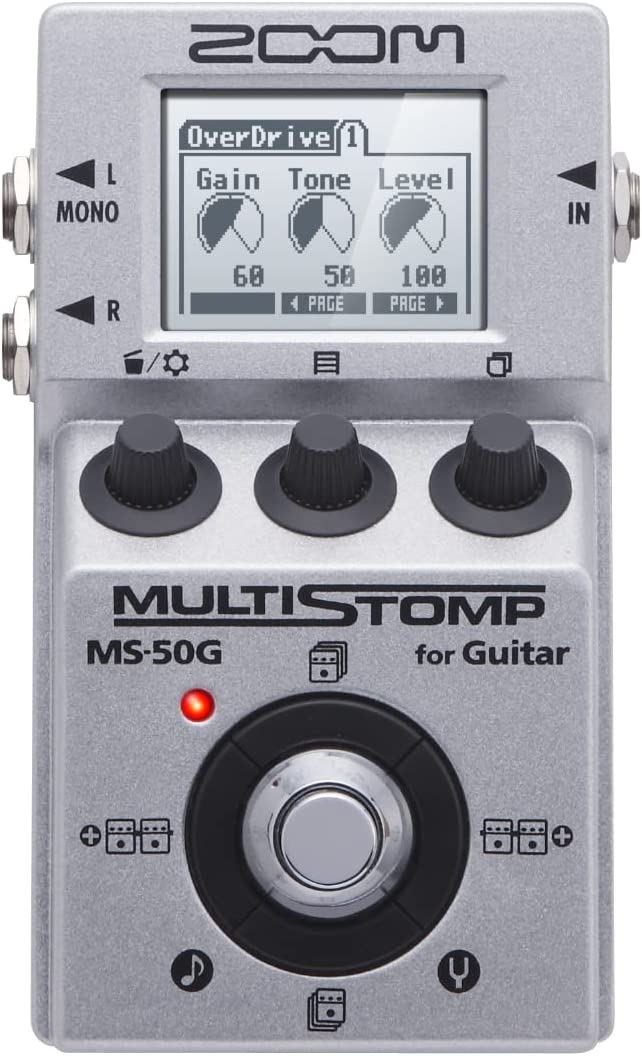
The Zoom MS50G MultiStomp Guitar Pedal is a versatile and compact device designed for guitar players looking for a wide range of effects in a single unit.
This Japanese version of the product comes with a Japanese manual.
The pedal is lightweight, weighing only 0.79 pounds, and has dimensions of 5.13 x 3.05 x 2.3 inches.
The device operates on 240 volts and 300 milliamps, making it efficient and reliable.
In addition, the Zoom MS50G offers multiple effects, allowing guitarists to experiment and create unique sounds.
It’s not just limited to effects, as it also includes a variety of amp simulations, allowing users to explore different tones.
One of the key aspects of this guitar pedal is its ease of use, making it suitable for both beginners and experienced musicians.
The LCD and intuitive controls make navigating various effects and settings simple.
Not simple that a power supply is not included with the pedal, so purchasing one separately or using batteries for portable use is recommended.
- My Review
I have had the pleasure of extensively using the Zoom MS50G MultiStomp Guitar Pedal, and I can attest to its remarkable versatility and usefulness for guitarists at all skill levels.
Whether you’re a novice or a seasoned player, this device will surely exceed your expectations.
In addition, its compact size and lightweight design make it an excellent addition to any pedalboard or practice space.
Navigating through the vast array of effects and amp simulations is a breeze, thanks to the intuitive controls and clear LCD.
The pedal offers an impressive range of tones, from shimmering cleans to roaring distortions, making it suitable for various music genres.
In addition, the ability to chain up to six effects simultaneously opens up a world of creative possibilities, allowing me to craft unique sounds tailored to my playing style.
One feature that stands out is the quality of the effects.
Despite its affordable price, the Zoom MS50G delivers top-notch sounds on par with more expensive units.
I particularly enjoyed experimenting with the delay and reverb effects, which added a new dimension to my playing.
However, the pedal is not without its shortcomings.
The battery life drains quickly, so a power supply is highly recommended.
Additionally, the limited user interface can be challenging to create custom effects.
Finally, it’s worth noting that the pedal does not come with a power supply or USB cable, so these need to be purchased separately.
In terms of durability, the metal chassis feels solid and built to withstand the rigors of regular use.
In addition, including an onboard tuner is a welcome bonus, ensuring that my guitar stays in tune during practice sessions or performances.
Here are the ratings I’ll give to the Zoom MS50G MultiStomp Guitar Pedal:
The Zoom MS50G MultiStomp Guitar Pedal provides exceptional value for money.
Though it may have some minor drawbacks, the sheer flexibility and quality of the effects make it a worthy investment for any guitarist looking to expand their sonic palette.
- Pros:
- Compact and lightweight design.
- Versatile effects and amp simulations.
- Intuitive controls and clear display.
- Cons:
- Drains batteries quickly.
- Creating custom effects can be challenging.
- Power supply and USB cable not included.
My final verdict is that the Zoom MS50G MultiStomp Guitar Pedal is an excellent choice for guitarists seeking a versatile, compact, and affordable effects unit.
Its wide range of effects, amp simulations, and intuitive interface make it a valuable addition to any musician’s toolkit.
Despite minor drawbacks, the pedal offers great value for money and is well worth considering for beginners and experienced players.
Mooer GE200 Multi-Effects Pedal
Powerful amp modeling and versatile effects with USB connectivity.
GE200 is a powerful, multi-effects processor with high-end amp modeling and versatile effects. It features easy-to-use controls and a variety of tones to explore, making it perfect for live performances or in the studio. Its diverse range of features and streamlined design make it an ideal choice for tone chasers.
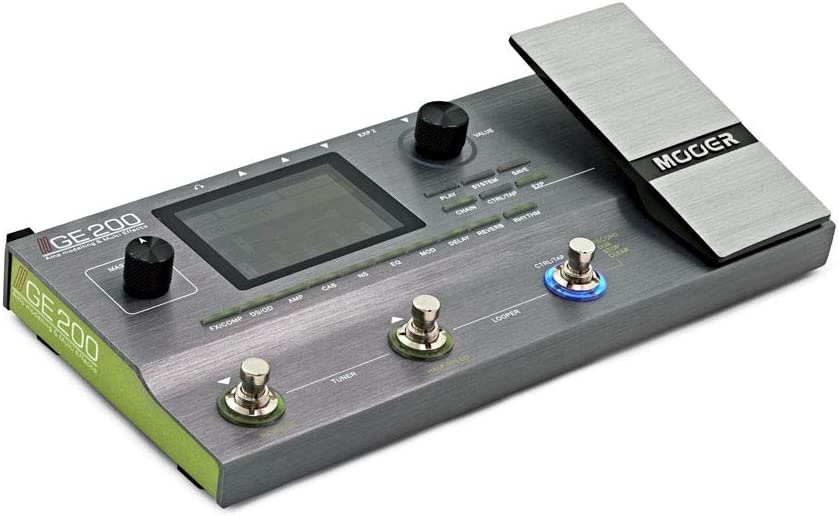
The Mooer GE200 Multi-FX is a compact and versatile multi-effects processor offering impressive features for guitarists.
This device provides 55 high-quality amplifier models, a 52-second looper with half-speed and reverse effects, and a drum machine with 40 drum patterns and ten metronome rhythms.
Moreover, it has USB connectivity, allowing for easy PC editing and direct audio recording to your computer.
Designed to be a musician’s ideal partner, the GE200 is well-suited for live performances, recording studios, or home practice sessions.
Its sleek black design measures 11.7 x 5.7 x 2.3 inches, and weighs just 3 pounds.
This multi-effects processor is a product of Mooer, a reputable brand known for its compact and stylish products.
With the GE200, you can achieve unparalleled amp modeling in its price range and a wide array of effects that cater to even the most discerning tone enthusiasts.
In addition, its intuitive controls and easy-to-read LED display make it a convenient and user-friendly option for musicians of all levels.
- My Review
I recently had the opportunity to try out the Mooer GE200 Multi-FX, and I must say, it truly impressed me.
Despite its small size, it packs a powerful punch as a multi-effects processor.
Its sleek and lightweight design makes it an ideal option for musicians who are frequently on the go, whether performing live, recording in the studio, or practicing at home.
One of the standout features of this device is its selection of 55 high-quality amplifier models.
This wide range offers ample options for tone enthusiasts, catering to various genres and playing styles.
In addition, the 52-second looper, complete with half-speed and reverse effects, adds a layer of creativity to the mix, making it a fantastic tool for experimenting with new ideas.
The drum machine, boasting 40 drum patterns and ten metronome rhythms, is a convenient addition for practicing and keeping time.
Meanwhile, the USB connectivity allows seamless PC editing and direct audio recording, making the GE200 a versatile companion in any musical setting.
However, it’s not all sunshine and rainbows.
One area where the GE200 could improve is its effects chain’s flexibility.
The inability to rearrange the order of effects can be limiting for some players who prefer more customization options.
The sound quality might not be to everyone’s taste, particularly for distorted tones.
Although it offers an impressive array of options, some players may find the overall sound overly processed or lacking warmth and naturalness.
Here are the ratings I’ll give to the Mooer GE200 Multi-Effects Pedal:
Despite these minor drawbacks, I found the Mooer GE200 Multi-FX a solid choice for musicians seeking a compact, feature-rich, and user-friendly multi-effects processor.
While it may not be perfect for everyone, its amp modeling, looping, and connectivity strengths make it a worthy contender in its price range.
- Pros:
- Compact and lightweight design.
- 55 high-quality amp models.
- Feature-rich with looper and drums.
- Cons:
- Limited effects chain customization.
- Distorted tones may lack warmth.
- Overly processed sound for some.
My final verdict is that the Mooer GE200 Multi-FX is a solid choice for musicians seeking a compact, feature-rich, and user-friendly multi-effects processor.
Its impressive amp modeling, looping, and connectivity options offer great value for its price range.
However, the limited effects chain customization and potential issues with distorted tones may not make it the perfect option for everyone.
It’s a versatile and reliable device for those exploring and expanding their musical horizons.
NUX MG-400 Multi-Effects Pedal
NUX MG-400 Multi Effects Pedal for realistic playability and tone tweaking.
NUX MG-400 is a versatile multi-effects processor with advanced amp modeling and pre-Efx algorithm, providing realistic playability and analog-chaos response. It includes 512 sample IR resolution, 10 independent flexible blocks, and Scene/Drum/Looper functions for convenient live performance.
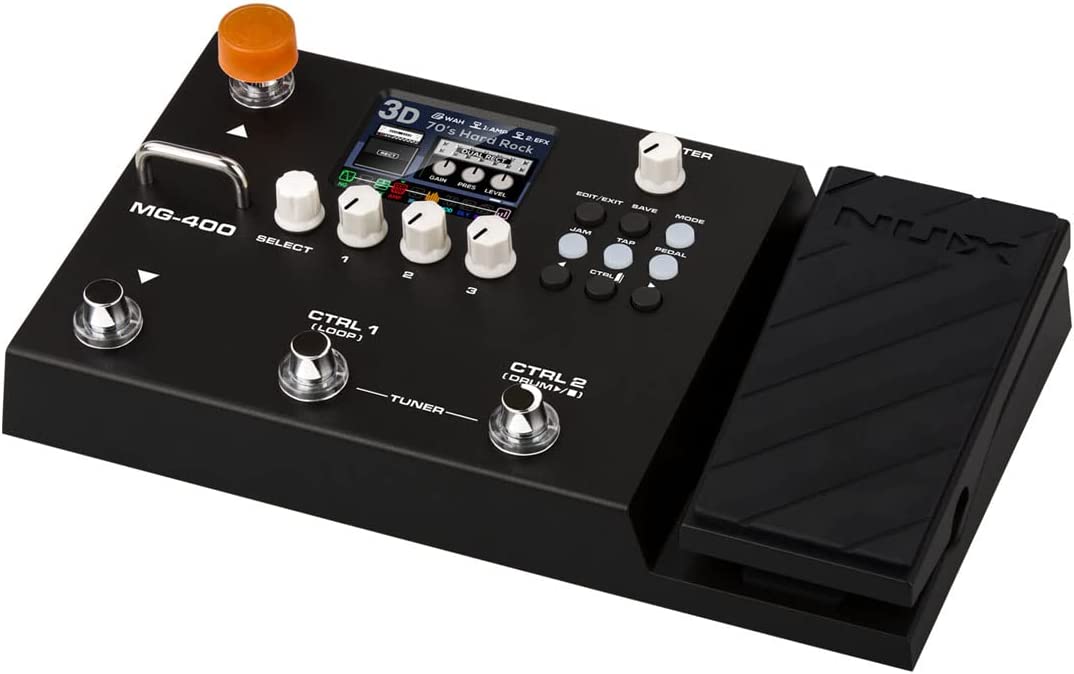
The NUX MG-400 is a versatile multi-effects pedal for electric and acoustic guitars.
This compact, black pedal offers amp modeling, 512 samples IR, and ten independent moveable signal blocks.
Its white-box amp modeling and pre-effects algorithm provides a realistic playing experience and responsiveness like an analog circuit.
Equipped with two powerful DSP chips, the MG-400 delivers high-definition amp modeling and core-image post-effects.
With 512 samples of IR resolution and a user slot for each patch, you can easily load 3rd party IR files for a customized sound.
The pedal also features 25 guitar cabinet IRs, eight bass cabinet IRs, and three acoustic guitar IRs.
The MG-400 allows for flexible block routing, making it simple to achieve various tone creations.
You can also assign CTRL1 or CTRL2 to trigger the Scene functionality, which can engage or disengage signal blocks freely.
Additionally, the pedal supports phrase loop synchronization with rhythm and offers two recording modes – Normal and Auto recording.
- My Review
After jamming with the NUX MG-400 Multi-Effects Pedal, I can say it’s like discovering a treasure chest for guitar players, overflowing with electric and acoustic guitar potential.
The amp modeling and pre-effects algorithm truly shines, delivering a playing experience that feels like you’re plugged into an actual analog amp and not just a digital imitation.
This versatile gadget has goodies, such as ten independent moveable signal blocks, various impulse responses, and a pair of potent DSP chips.
Imagine having a playground of guitar tone possibilities right at your feet, just waiting for you to explore and experiment.
In addition, the Scene functionality is like a secret weapon during live performances, allowing you to switch signal blocks on and off easily.
The built-in drum and looper features are like having a personal rhythm section backing you up during practice sessions, with the phrase loop synchronization keeping your grooves in perfect sync.
The MG-400 also serves as a trusty sidekick for recording, offering both Normal and Auto modes.
Of course, no treasure is without a few rough edges.
The editing software can feel like navigating a maze, requiring patience and learning to master.
The amps’ bass and mid-tone controls might not shake the earth, but the responsive EQ effect block can help you sculpt your sound perfectly.
The NUX MG-400 is like a Swiss Army knife for guitarists, offering a wide array of features at an unbeatable value.
Here are the ratings I’ll give to the NUX MG-400 Multi-Effects Pedal:
Its lifelike amp modeling, flexible signal routing, and powerful effects make it a must-have addition to any guitarist’s arsenal.
So why not let this multi-effects pedal unleash creativity and elevate your playing experience?
- Pros:
- Realistic amp modeling experience.
- Flexible signal routing options.
- Drum and looper functions included.
- Cons:
- Editing software has learning curve.
- Limited bass and mid tone controls.
- Intuitive navigation could be improved.
My final verdict is that the NUX MG-400 Multi Effects Pedal is a highly versatile and feature-rich pedal that delivers impressive tone and performance.
With its excellent value and strong brand reputation, it’s a worthy addition to any guitarist’s gear collection.
Boss GX-100 Guitar Multi-Effects Pedal
Legendary BOSS quality multi-effects pedal with amp/effects modeling and USB recording interface.
BOSS compact effects, multi-effects, loopers, and rhythm machines. BOSS is committed to providing products that exceed the expectations of musicians everywhere, with a focus on performance, reliability, and quality. BOSS offers trusted guitar effects, multi-effects, loopers, and rhythm machines to exceed the expectation of musicians everywhere, delivering reliable performance and quality.
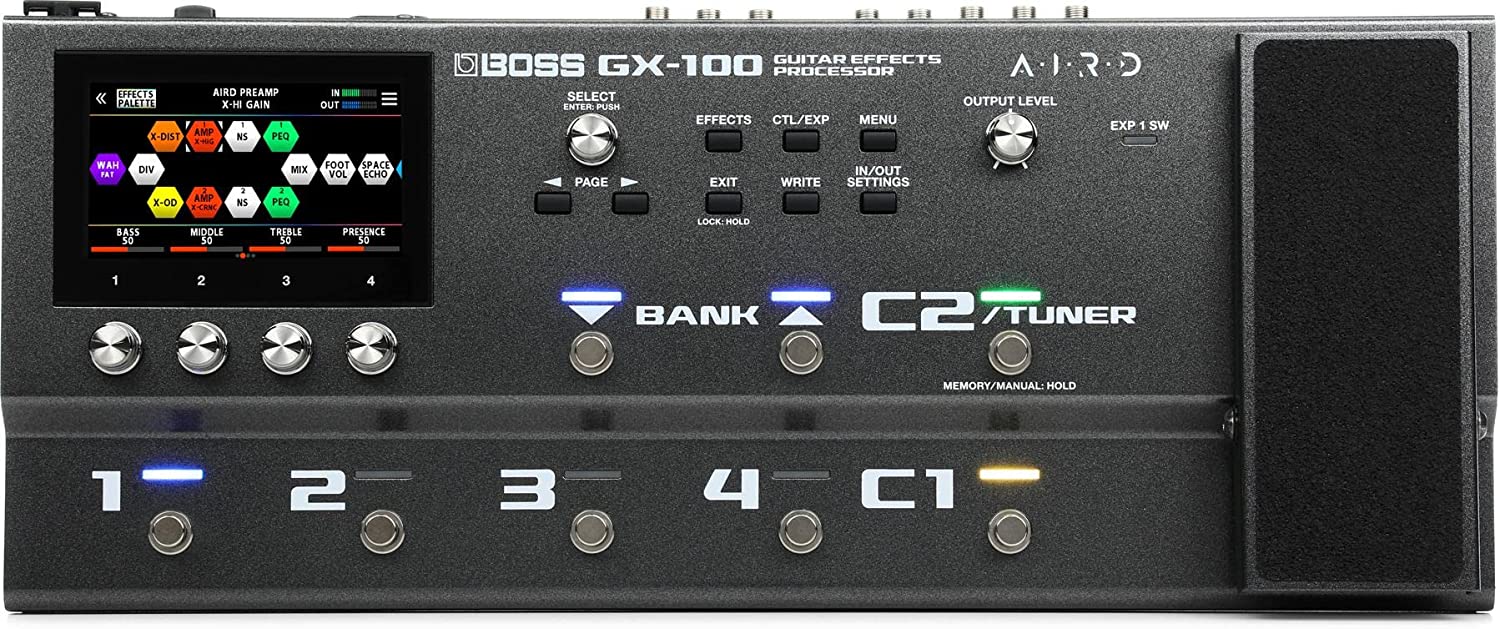
The Boss GX-100 Guitar Multi-effects Pedal is a versatile and powerful tool designed for guitarists and bassists alike.
This compact, all-in-one device boasts many features, including amp and effects modeling, a USB recording interface, an expression pedal, and a color touchscreen for easy navigation.
Users can easily create unique and dynamic sounds with 23 AIRD amplifiers and over 150 effects derived from the flagship GT-1000.
This sleek, black effects processor measures 23.7 x 11.2 x 5.55 inches and weighs 9.68 pounds, making it a sturdy and portable addition to your setup.
The GX-100 allows up to 15 simultaneous effect blocks, providing endless possibilities for tone experimentation.
Additionally, it offers real-time control via onboard footswitches, an expression pedal, and external control support.
Designed by the renowned BOSS brand, the GX-100 is ideal for use on stage, in the studio, or at home.
Its intuitive interface and advanced tone technologies make it a top choice for musicians looking to enhance their sound and performance capabilities.
- My Review
Upon using the Boss GX-100 Guitar Multi-effects Pedal, I was pleasantly surprised by its performance and capabilities.
This compact, all-in-one device packs a punch with its 23 AIRD amplifiers and over 150 effects, offering many tonal options to explore.
In addition, the color touchscreen made navigating the settings a breeze, though it took some time to adjust to the screen’s sensitivity.
When it comes to amp modeling, the GX-100 may not have the most extensive selection compared to some competitors, but what it lacks in quantity, it makes up for in quality.
I was impressed by the authentic tube amp to feel it provided, even when playing through a PA system.
As you’d expect from a BOSS product, the effects were top-notch, and I appreciated the flexibility in arranging the effect blocks to create my desired sound.
One aspect that required patience and dedication was fine-tuning the settings to get the perfect tone.
The factory presets didn’t do the pedal justice, so diving into the parameters and customizing your sound is essential.
While this might be a challenge for those new to BOSS products, it’s well worth the effort to unlock the full potential of the GX-100.
As a recording interface, the GX-100 performed admirably, providing low latency and excellent sound quality.
However, remember that effect changes are not possible post-recording like with some plugins, so having your desired settings in place before hitting the record button is essential.
Here are the ratings I’ll give to the Boss GX-100 Guitar Multi-Effects Pedal:
Built like a tank, the GX-100 is a reliable and robust companion for any musician, whether on stage, in the studio, or at home.
Though it may require some effort to master, the result is a versatile and satisfying multi-effects pedal that delivers superb sound quality and endless creative possibilities.
- Pros:
- Wide range of amps and effects.
- Intuitive color touchscreen interface.
- Sturdy, portable build quality.
- Cons:
- Requires time to fine-tune settings.
- Factory presets not impressive.
- Screen sensitivity takes adjustment.
My final verdict is that the Boss GX-100 Guitar Multi-effects Pedal is an excellent choice for musicians seeking a versatile, portable, and high-quality multi-effects unit.
With a wide range of amps and effects, an intuitive touchscreen interface, and a sturdy build, it delivers impressive performance and creative possibilities.
While it may require some time to fine-tune settings and adjust to the screen sensitivity, the result is a satisfying and powerful tool for any guitarist or bassist.
Zoom G5n Guitar Multi-Effects with Expression Pedal
Create limitless tones with Zoom’s G5n Guitar Multi-Effects Processor.
The Zoom G5n Multi-Effects Processor for Guitarists offers 126 boutique pedal sounds and 10 classic amp models in one innovative package, plus a two-unit Looper and expression pedal for real-time control. Easily edit and create your own signature sound with four independent editing displays and up to nine effects and amp/cabinet models.
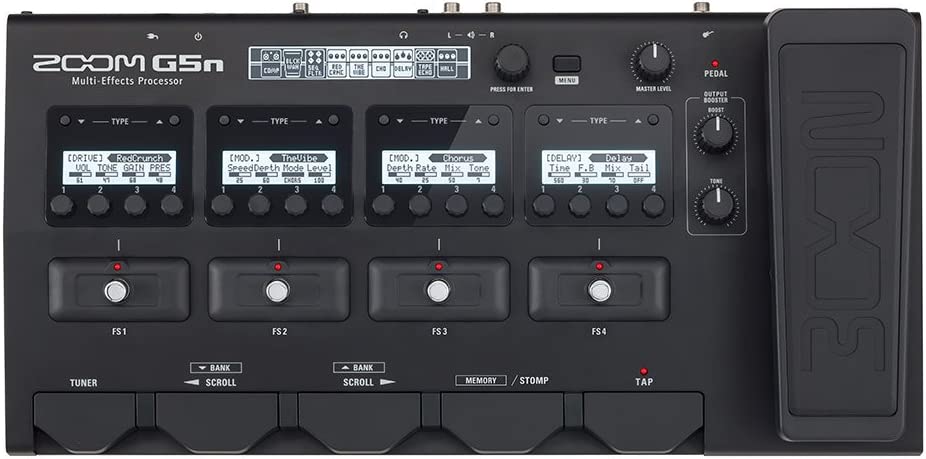
The Zoom G5n Guitar Multi-Effects Processor is a highly versatile and innovative device that offers a wide range of high-quality digital effects, amp, and cabinet emulations for guitarists.
It boasts over 68 onboard effects, ten ultra-realistic amp and cabinet emulators, and 100 custom-crafted effects chains created by professional guitarists.
In addition, the built-in expression pedal allows for real-time control, and the stereo/mono looper can record up to 80 seconds.
This processor is also a USB audio interface compatible with Mac and Windows.
Zoom’s G5n features various essential guitar sounds, including overdrive, distortion, compression, EQ, delay, reverb, flanging, phasing, vibrato, and more.
Additionally, it offers unique multi-effects like Seq Filter, Gold Drive, Reverse Delay, HD Hall, and OSC Echo.
The device is designed with user-friendly editing displays and four independent banks for easy customization.
The durable and well-built G5n is perfect for guitarists looking to explore and create a variety of tones and effects in a single, compact unit.
- My Review
Let me tell you about my experience with the Zoom G5n Guitar Multi-Effects Processor.
When I first unboxed this beauty, I was excited to explore its world of possibilities.
Right off the bat, I noticed its solid build and attractive design.
But, as with any new gadget, there’s a bit of a learning curve to navigate.
Once I began tinkering with the G5n, I realized that the built-in presets weren’t up to par.
So, I rolled up my sleeves and dove into creating my tones.
That’s where the magic happened!
With loads of amp models and effects to choose from, it felt like a treasure trove of sonic delights.
The G5n’s screens were informative and easy to read, even if the fonts could be slightly bigger.
On the other hand, the bottom row of buttons was a bit tricky to hit accurately, especially for someone with larger feet like me.
Still, the overall feel and responsiveness of the stompbox-style footswitches were quite impressive.
As for the sound quality, it was exceptional for the price.
I managed to produce some killer clean tones and decent distortion, though it took a bit of tweaking.
However, the looper and rhythm section left something to be desired, as they were tied to the effects chain and couldn’t be used independently.
Despite these minor drawbacks, the Zoom G5n is a versatile multi-effects pedal that offers incredible value for money.
It’s perfect for those who love experimenting with different sounds and combinations.
Here are the ratings I’ll give to the Zoom G5n Guitar Multi-Effects with Expression Pedal:
Just remember to be patient, as finding your ideal tone may take some time and effort.
But in the end, it’s worth the journey.
- Pros:
- 100+ built-in effects and amp models.
- Built-in expression pedal for control.
- USB audio interface for recording.
- Cons:
- Initial presets are not great.
- Complex interface for new users.
- Processing limit reached quickly.
My final verdict is that the Zoom G5n Guitar Multi-Effects Processor is a versatile and feature-packed option for guitarists seeking a wide range of effects and amp models.
However, its complex interface and less-than-impressive presets may require patience and tweaking to achieve the desired sound.
But, overall, it’s a solid choice for those willing to invest time in customization and fine-tuning.
Line 6 HX Stomp Multi-Effects Guitar Pedal
Compact, powerful, and versatile multi-effects pedal with pristine audio quality.
HX Stomp is a professional-grade multi-effects processor pedal providing Helix amp, cab, and effect models, plus legacy Line 6 models, in a compact stompbox. With 6 simultaneous blocks, intuitive controls, and flexible routing, it provides a complete rig in one pedal.
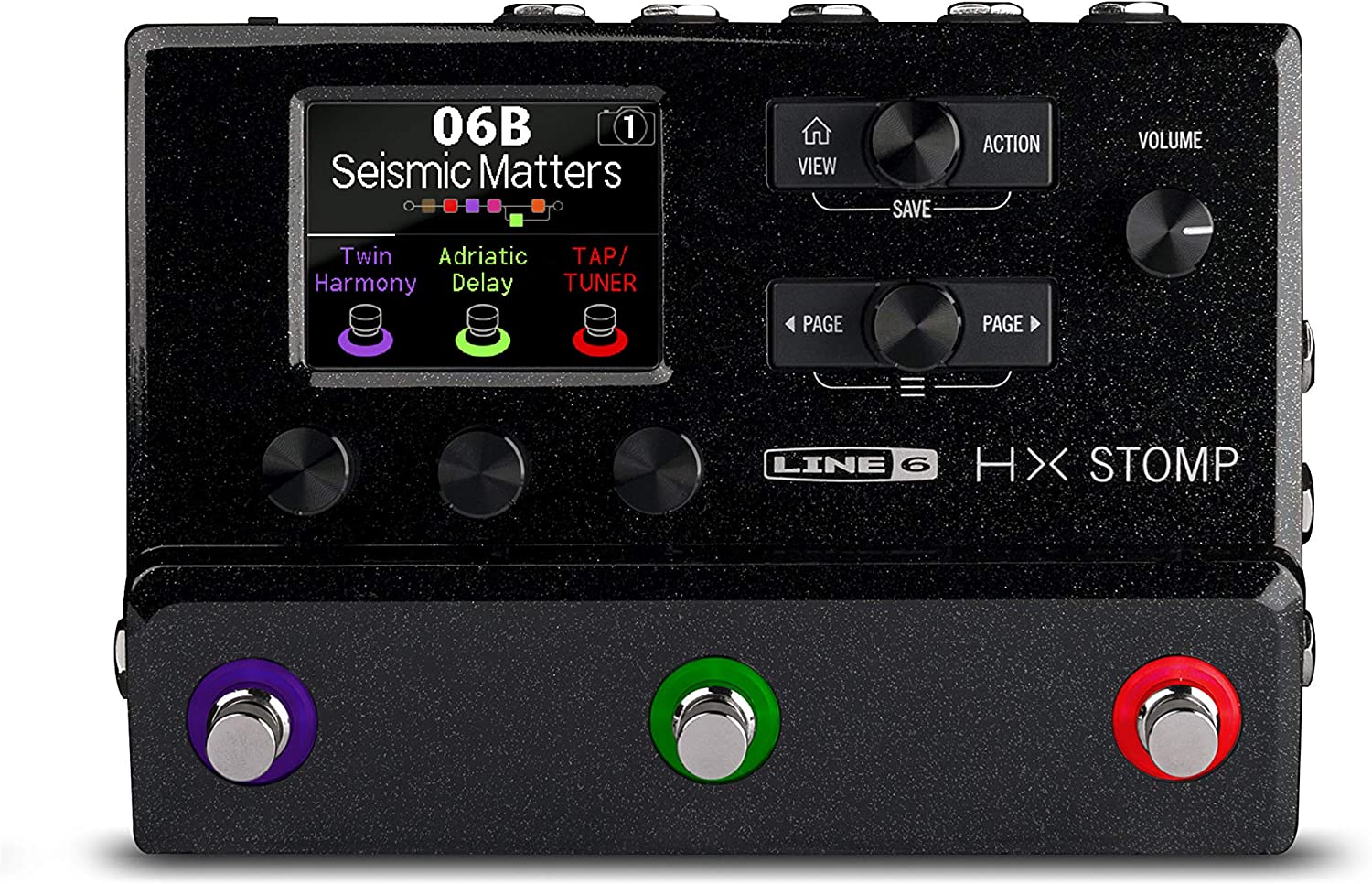
The Line 6 HX Stomp Multi-Effects Guitar Pedal in black is a professional-grade, compact processor that offers the sound quality of Helix amps, cabinets, and effects.
It features HX Modeling technology, which allows it to run up to 6 processing blocks simultaneously.
This powerful stompbox-sized processor has over 300 effects and models from the Helix, M-Series, and legacy Line 6 products.
Designed for versatility, the HX Stomp can be used as a standalone stompbox, a backup or travel rig, combined with other modelers, an audio interface, or even a complete rig for guitar and effects studio recording.
It has three capacitive-sensing footswitches with color-coded LED rings, making editing fast and easy.
The pedal also includes a TRS dual expression pedal/footswitch input for extended creative control capabilities.
The HX Stomp’s compact size does not compromise audio quality, offering 123dB of dynamic range for exceptional depth and ultra-low noise.
Its intuitive control and editing options, extensive MIDI control, IR loading capabilities, and multichannel 24-bit/96kHz USB audio interface make this pedal a powerful tool for any guitarist.
- My Review
Having spent quality time with the Line 6 HX Stomp Multi-Effects Guitar Pedal, I’d like to share my thoughts on this compact yet powerful device.
First and foremost, the sound quality is truly impressive.
The HX Modeling technology allows for a wide range of tones and effects, allowing me to experiment and find the perfect sound for any situation.
When it comes to usability, the HX Stomp does have a bit of a learning curve.
However, once I got the hang of it, the intuitive controls and color-coded LED rings on the footswitches made navigating and editing my settings a breeze.
The desktop software, HX Edit, also proved valuable in customizing my presets and managing my signal chain.
One limitation I encountered was the maximum of six processing blocks that can be used simultaneously.
While this might be enough for some users, I occasionally wished to add another effect to my setup.
The vast array of amp models, cabinets, and effects in the HX Stomp still allowed for much creative freedom.
The HX Stomp is solid and robust in terms of build quality, making it well-suited for studio use and live performances.
The inclusion of a TRS dual expression pedal/footswitch input also adds an extra layer of control, enabling me to fine-tune my sound on the fly.
One minor gripe is that the power cord is short, which may be inconvenient for some users.
However, this is a relatively minor issue that can be easily resolved with an extension lead.
Here are the ratings I’ll give to the Line 6 HX Stomp Multi-Effects Guitar Pedal:
The Line 6 HX Stomp is a versatile and powerful multi-effects guitar pedal that offers impressive sound quality and a range of customization options.
Despite its limitations and learning curve, it’s a valuable tool for any guitarist seeking a compact and flexible solution for enhancing their sound.
- Pros:
- Professional-grade sound quality.
- Compact and versatile design.
- Intuitive control and editing options.
- Cons:
- Limited to 6 processing blocks.
- Steep learning curve for some users.
- Power cord may be too short.
My final verdict is that the Line 6 HX Stomp Multi-Effects Guitar Pedal is a highly versatile and powerful tool for guitarists seeking professional-grade sound quality in a compact design.
Its range of features, impressive tone, and solid performance make it an excellent investment for musicians looking to expand their creative possibilities.
In addition, the reputable Line 6 brand and overall value of the pedal further solidify it as a top choice for those searching for a multi-effects processor.
What exactly is a guitar multi-effects pedal?
A guitar multi-effects pedal is a versatile and powerful tool that allows guitarists to access and combine a wide range of effects in a single compact device.
This type of pedal has become increasingly popular among musicians of all skill levels, as it offers an affordable and convenient solution for those looking to expand their sound palette without the need for multiple individual effect pedals.
At its core, a guitar multi-effects pedal is an electronic device that processes the raw audio signal from your guitar and modifies it in various ways to create different sounds and tones.
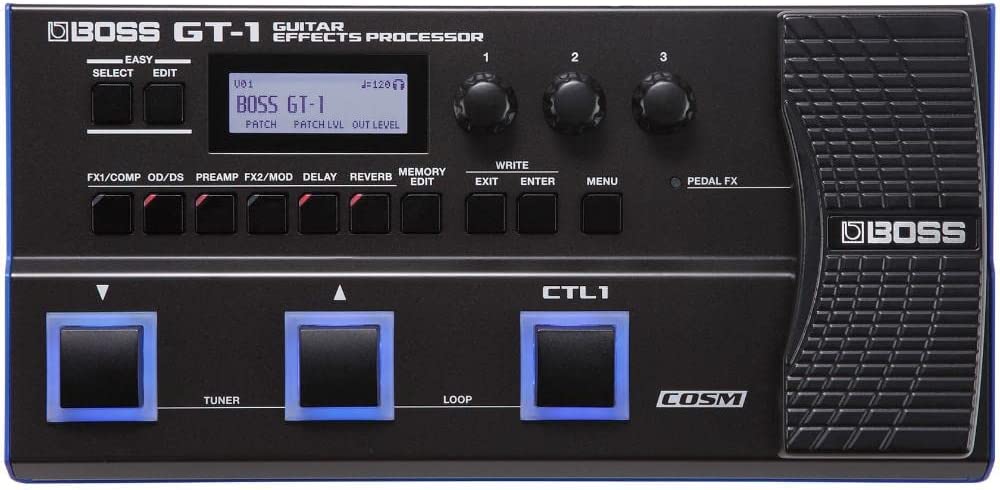
This is achieved through digital signal processing (DSP) technology, which enables the pedal to emulate the sound of various traditional analog effects, such as distortion, chorus, delay, reverb, and more.
By consolidating these effects into a single unit, guitarists can save space on their pedalboard, reduce setup time, and streamline performance.
One of the main advantages of using a multi-effects pedal is the ability to create and store custom patches or presets.
Each preset combines different effects, settings, and parameters that can be saved and recalled at the touch of a button.
This lets guitarists switch between different sounds during a live performance or recording session without manually adjusting individual effect pedals.
In addition, many multi-effects pedals also feature built-in expression pedals, which allow users to control certain parameters, such as the level of distortion or the speed of a modulation effect, in real time as they play.
Another important aspect of a guitar multi-effects pedal is its user interface and ease of use.
Most multi-effects pedals feature a combination of knobs, buttons, and footswitches that allow users to navigate through menus, adjust parameters, and engage or bypass different effects.
Some models also come equipped with an LCD screen, which provides visual feedback on the current settings and makes it easier to edit and create patches.
While the learning curve for using a multi-effects pedal may be steeper than that of individual effect pedals, the flexibility and customization these devices offer to make them a valuable addition to any guitarist’s arsenal.
In addition to the wide range of effects available on a guitar multi-effects pedal, many units include built-in amp modeling and speaker simulation technology.
This enables users to emulate the sound of different amplifier and speaker combinations, providing even more tonal options and versatility.
With amp modeling, guitarists can experiment with various amp sounds without investing in multiple amplifiers, making it an ideal solution for those on a budget or with limited space.
Some multi-effects pedals also offer direct recording capabilities, allowing users to connect the pedal directly to a computer or recording interface without needing an external amplifier or speaker.
It’s worth noting that while a guitar multi-effects pedal offers many advantages, some purists argue that individual effect pedals provide a more authentic and organic sound.
This is because multi-effects pedals often rely on digital signal processing to emulate the sound of analog effects, which can result in a less natural and “processed” tone.
However, advancements in DSP technology have led to significant improvements in the quality and realism of digital effects, making it increasingly difficult to distinguish between the two.
What should you consider when choosing a guitar multi-effects pedal?
When choosing a multi-effect pedal guitar, there are several factors to consider.
We will delve into these factors to help you decide when to select the perfect multi-effects pedal for your needs.
– Sound quality
The most crucial aspect of any guitar effects pedal is its sound quality.
High-quality multi-effects pedals should provide a wide range of clear, precise, and natural-sounding effects that suit your music style.
To determine the sound quality of a pedal, it is essential to test it with your guitar and amplifier, as some pedals may sound better with certain combinations of gears.
Additionally, consider whether the pedal offers true bypass, which allows your guitar signal to pass through the pedal unaffected while not engaged, preserving your guitar’s original tone.
– Controls and features
Another essential factor to consider is the controls and features provided by the multi-effects pedal.
Look for a pedal with an intuitive interface and easy-to-use controls, allowing you to navigate and adjust your desired effects quickly.
Some pedals offer additional features such as loopers, tuners, and built-in expression pedals, providing added functionality and convenience.
Consider your preferences and the type of effects you frequently use when selecting a pedal with the right controls and features.
– Analog vs. digital
The guitar community has an ongoing debate on the merits of analog vs. digital multi-effects pedals.
Analog pedals use analog circuitry and offer a more “organic” sound, while digital pedals use digital signal processing to emulate various effects.
Some players prefer the warmth and character of analog pedals, while others appreciate the versatility and consistency of digital pedals.
Ultimately, the choice between analog and digital comes down to personal preference and the type of sound you aim to achieve.
– Build quality and durability
A well-built and durable multi-effects pedal is essential for those who frequently gig or travel with their gear.
Look for a pedal with a sturdy metal chassis that can withstand the rigors of regular use.
Additionally, consider the quality of the switches and knobs, ensuring that they feel robust and reliable.
Investing in a durable pedal can save you money in the long run by preventing the need for frequent repairs or replacements.
– Presets and versatility
One of the primary benefits of a multi-effects pedal is the ability to access a wide range of effects within a single unit.
Therefore, look for a pedal with sufficient presets and the ability to customize and save your settings.
This lets you quickly switch between different effects and create unique combinations suited to your playing style.
Additionally, consider the types of effects the pedal offers and whether they align with your preferences and needs.
– Brand reputation
While brand reputation should not be the sole factor in your decision, it is worth considering when choosing a multi-effects pedal.
Well-established brands with a history of producing high-quality gear are more likely to offer reliable and durable products.
Researching different brands and their reputations can help you make a more informed decision and ensure you invest in a pedal that will serve you well for years.
– Price and budget
As with any musical gear, the price of a multi-effects pedal can vary widely.
Set a budget for your purchase and consider the features and quality that are most important to you.
While opting for the cheapest option is tempting, investing in a higher-quality pedal with the needed features can save you money and frustration in the long run.
– Reviews and recommendations
Finally, consult reviews and recommendations from fellow guitarists, online forums, and music publications to help you narrow down your options.
Other players’ experiences with a particular pedal can provide valuable insight into its sound quality, ease of use, and durability.
Additionally, seeking recommendations from guitarists with similar music styles and preferences can help you find a pedal well-suited to your needs.
How to properly use a guitar multi-effect pedal?
In this section, we’ll take a look at how to properly use a guitar multi-effect pedal.
With so many features available to you in just one interface, it can get a bit confusing to use.
By understanding the basics and utilizing these tips, you can unlock your pedal’s full potential and improve your performance.
– Familiarize yourself with the controls and features:
The first step in properly using a guitar multi-effect pedal is to familiarize yourself with its controls and features.
Spend some time with the pedal’s manual, as it will provide essential information about the functions of each knob, button, and switch.
Additionally, exploring the preset effects to understand the various sounds the pedal can produce is a good idea.
To make the most of your pedal, you should be comfortable adjusting effect parameters, saving custom settings, and selecting presets.
This may take some experimentation, but learning how to use the pedal effectively is essential.
In addition, familiarizing yourself with the controls and features will enable you to make the necessary adjustments quickly and confidently during live performances or recording sessions.
– Adjust the parameters to suit your musical goals:
Once you are familiar with the controls and features of your guitar multi-effect pedal, the next step is to tailor the effects to suit your musical goals.
Each effect will have unique parameters, such as delay time, reverb depth, or modulation rate.
Experiment with these parameters to find the settings that best complement your playing style and the specific sound you want to achieve.
Remember the overall mix and the other instruments in your band or recording when adjusting the parameters.
It is essential to balance achieving your desired sound and ensuring the effects do not overpower or clash with other elements in the mix.
Remember that subtle adjustments can often significantly impact the overall sound, so take the time to fine-tune your settings until you are satisfied with the results.
– Incorporate the guitar multi-effect pedal into your signal chain:
One of the critical aspects of using a guitar multi-effect pedal is incorporating it into your signal chain properly.
The signal chain refers to the order in which your guitar effects are connected, from your guitar to your amplifier.
Placing your multi-effect pedal within the signal chain can greatly impact its performance and the overall sound.
As a general rule of thumb, placing the multi-effect pedal after any individual stompboxes in your signal chain, especially those that shape your core tones, such as overdrive or distortion pedals, is recommended.
This arrangement allows the multi-effect pedal to process a clean and consistent signal, ensuring the effects remain clear and precise.
Again, however, experimentation is key, and you may find that a different placement works better for your specific setup and preferences.
– Use it when needed / don’t overuse it
When using a guitar multi-effect pedal, it is essential to use the effects tastefully to enhance your overall sound without overpowering it.
While it can be tempting to stack multiple effects and create complex soundscapes, this can often result in a muddy or cluttered mix that detracts from your guitar’s natural tone and the other instruments in your band or recording.
To use the effects in a way that will sound good, consider the following tips:
Less is often more, meaning start subtly applying effects and gradually increase the intensity if necessary.
This approach will help you find the sweet spot where the effects enhance your sound without becoming overpowering.
Choose complementary effects by selecting effects that work well together and complement your playing style.
For example, if you play lead guitar, you may want to use effects that add sustain and depth, such as delay and reverb, while rhythm players might benefit from more percussive effects like chorus or tremolo.
Be mindful of dynamics and consider how the effects will impact the dynamics of your playing.
For example, some effects, such as compression, can flatten your dynamics, while others, like delay and reverb, can add depth and dimension to your sound.
Strike a balance between maintaining the natural dynamics of your playing and achieving the desired effect.
How to order pedals on a pedalboard?
There is no one-size-fits-all approach to ordering pedals on a pedalboard, as the optimal arrangement largely depends on the specific sound you’re aiming for.
Usually, though, you will see guitar players mostly agreeing with this order:
Tuner > Filters/Dynamics > Pitch-based Effects > Overdrive/Distortion > Modulation > Time-based Effects > Looper
Aside from that, some general guidelines can help you achieve a balanced and versatile setup.
Let’s talk in detail about the order we just mentioned, but feel free to experiment and adjust to your own preferences:
- Tuner: Place your tuner pedal first to ensure your signal is in tune before passing through the other pedals.
- Filters and dynamics: Wah-wah, envelope filters, compressors, EQs, and noise gates should come next. These pedals affect your sound’s dynamic and tonal aspects, so it’s best to place them early in the chain.
- Pitch-based effects: Octavers, harmonizers, and pitch shifters should come after filters and dynamics since these pedals alter the pitch of your signal and work best with a clean, unprocessed sound.
- Overdrive and distortion: Overdrive, distortion, and fuzz pedals typically come next. They shape your guitar’s core sound, and placing them before most other effects ensures that those effects receive a strong, consistent signal.
- Modulation effects: Chorus, flanger, phaser, and tremolo pedals should be placed after overdrive and distortion effects. We do this to allow these pedals to add depth and movement to your sound without becoming overly distorted or overbearing.
- Time-based effects: Delay and reverb pedals should be placed towards the end of your signal chain. This allows them to create a sense of space and depth around the other effects, simulating the sound of a room or hall.
- Looper: If you use a looper pedal, it should be placed last in the chain. This ensures that you’re looping the entire signal, including all the effects you’ve applied.
Remember, these are just general guidelines and what generally works and sounds good.
The most important thing is to experiment and find the arrangement that best suits your personal sound and style.
For example, here’s one pedalboard signal chain that I always use:
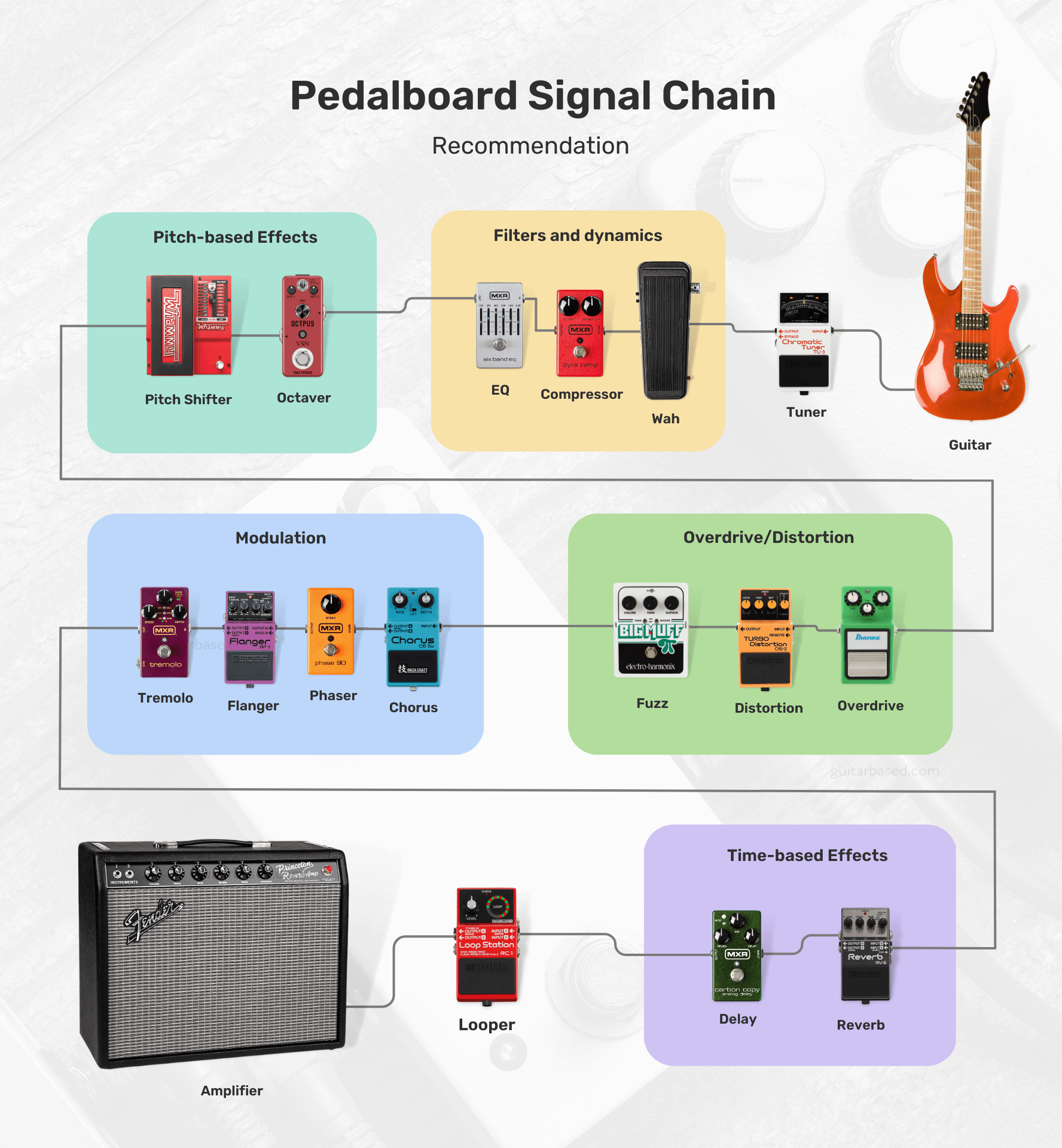
Feel free to swap the order of pedals, try different combinations, and test out unconventional setups until you find the one that works best for you.
For those interested, I’ll leave you with most of the possibilities that you’ll encounter and how to order them.
- Tuner
- Filters/Dynamics:
- Volume
- Wah
- Auto-Wah
- Compressor
- Noise Gate
- EQ (Equalizer)
- Pitch-based Effects:
- Octaver
- Harmonizer
- Pitch Shifter
- Overdrive/Distortion/Fuzz:
- Boost
- Overdrive
- Distortion
- Fuzz
- Modulation:
- Chorus
- Phaser
- Flanger
- Univibe
- Vibrato
- Tremolo
- Time-based Effects:
- Delay
- Echo
- Reverb
- Synth/Bitcrusher:
- Synth
- Bitcrusher
- Acoustic Simulator
- Multi-Effects
- Utility:
- Buffer
- A/B/Y Switcher
- MIDI Controllers
- Looper
Boutique vs. Mass-Produced pedals
Boutique pedals are generally built with higher-quality components and craftsmanship, resulting in better durability and longevity.
These pedals often feature unique and innovative designs, providing a wider range of tones and effects that may not be available in mass-produced options.
Here are a few examples of boutique pedals:

All the manufacturers also tend to have a more personal approach, with better customer service and the ability to customize pedals according to the user’s preferences.
However, boutique pedals are usually more expensive due to the smaller scale of production and the use of premium components.
Mass-produced pedals, on the other hand, are more affordable due to their larger scale of production and the use of cost-effective components.
These pedals are widely available and offer a range of popular effects, making them accessible to a larger audience.
Here are a few examples of mass-produced pedals:

The quality control for mass-produced pedals can vary depending on the brand and model, but many are reliable and offer good value for the money.
As for one of the downsides, you’ll find that mass-produced pedals may not have the same level of uniqueness or innovation as boutique options.
On the other hand, they may not provide the same level of customer service or customization options.
The choice between boutique and mass-produced pedals depends on your personal preferences, budget, and desired sound.
If you’re looking for unique tones, higher-quality components, and a more personal experience, boutique pedals may be the way to go.
But I would say, for those who are on a budget and need access to popular effects, mass-produced pedals might be a better fit.
It’s worth trying out both types to see which best suits your needs and playing style.
How much should you spend on a guitar pedal?
If I were in your position, I would first determine my budget and specific needs before deciding how much to spend on a guitar pedal.
For beginners, it might be more reasonable to start with affordable, mass-produced pedals to explore different effects without spending too much.
Guitar pedals can range in price from around $30 to over $400, depending on the brand, quality, and complexity of the effect.
As your skills and understanding of your preferred tone develop, you can gradually upgrade to higher-quality or boutique pedals.
One thing I would do is consider which effects are essential to your playing style and prioritize purchasing those first.
Allocating a larger portion of your budget to the most important pedals might be a wise choice, especially if you only need a few basic effects.
However, if you require a wide array of effects, you may want to consider more budget-friendly options or multi-effects units.
Keep in mind that higher-priced pedals often come with better build quality, unique features, and improved sound quality.
But I would also say that price is not always directly correlated with quality or suitability for your needs.
Sometimes, a more affordable pedal can deliver the exact sound you’re looking for, while a higher-priced option might not meet your expectations and are only expensive because of the brand reputation.
Can you use a guitar pedal with a bass guitar?
You can certainly use a guitar pedal with a bass guitar.
But it’s crucial to be aware that some guitar pedals may not be specifically designed to accommodate the frequency range of a bass guitar.
This could result in a less-than-ideal performance or an altered tone that might not be what you were expecting.
If you’re feeling adventurous and eager to experiment with your sound, don’t hesitate to connect your guitar pedals to your bass guitar.
This can be a fun way to explore different sonic possibilities, and you might even stumble upon some unique tones that complement your playing style perfectly.
Using a guitar pedal with a bass guitar may not always produce the desired results.
In some cases, the low-end frequencies might be lost, or the effect could sound too harsh or muddy.
To avoid these issues, you could consider looking into pedals that are specifically designed for bass guitars.
These pedals are engineered with the bass frequency range in mind, ensuring that your low-end remains intact and the effect sounds as intended.
In addition to bass-specific pedals, there are also multi-effects processors and pedals that cater to both guitar and bass players, offering a wide range of effects and tonal options.
These versatile units can be a great solution if you play both instruments and want a single device to cover your needs.
How to properly power your pedals?
When it comes to powering your pedals, you want to make sure you’re doing it right to avoid any noise issues or potential damage.
First, check each pedal’s power requirements, which you can usually find in the manual or on the pedal itself.
You’ll want to pay attention to the voltage (usually 9V, 12V, or 18V) and current (measured in milliamps or mA).
Now, you’ve got a few options for powering your pedals.
You can use individual power supplies or batteries for each pedal, but that can get messy and inconvenient.
I’d recommend going for a pedal power supply or an isolated power brick.

For example here are a few ones I recommend:
- Voodoo Lab Pedal Power 2 Plus Isolated Power Supply (My favorite)
- Rowin PW-1 Guitar Pedal Power Supply (Cheapest)
These babies can power multiple pedals at once, and the isolated outputs help prevent noise and ground loop issues.
Just make sure the power supply you choose can handle the voltage and current requirements of all your pedals.
When you’re connecting everything, use good quality power cables and keep them neat and tidy to avoid a tangled mess.
You might even want to use cable ties or cable organizers to keep everything in order.
In love with guitars, and gear; expert in all things music! Been writing about guitars for about 5 years and counting. Born in the ’90s. Alma Mater: University of Havana. Always curious, trying to understand the world. #TeamFender

